#but shes serving him water via ladle
Text
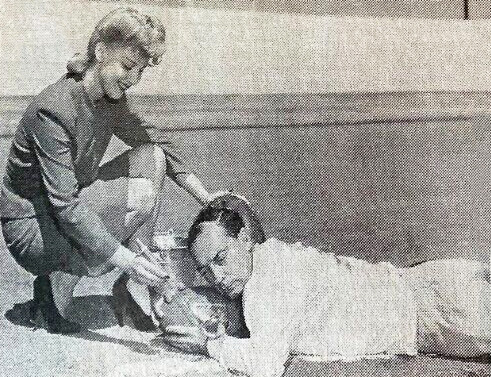
Buster Keaton and ?
#buster keaton#1930s#1910s#1920s#1920s hollywood#silent film#silent comedy#silent cinema#silent era#silent movies#pre code#pre code hollywood#pre code film#pre code era#pre code movies#damfino#damfinos#vintage hollywood#black and white#buster edit#old hollywood#slapstick#I have no idea date or who this is#but shes serving him water via ladle
5 notes
·
View notes
Text
Everything You Need to Stock an at-Home Bar
So you finally found the bar cart of your dreams, and you’ve loaded it up with your favorite liquor. While those are two very important steps to curating an at-home bar, to really make your setup recall that of your favorite watering hole, you’re going to want to add some barware and cocktail equipment. But that can be an intimidating task, especially if you’ve had more experience drinking cocktails than making them. The good news is that you don’t have to spend a lot of money. “Most people in their home bar really don’t need that many tools,” advises Joaquín Simó, a partner at New York City’s Pouring Ribbons who was named Tales of the Cocktail’s American Bartender of the Year in 2012. “I say you start with the absolute basics and concentrate on the things that you like to use.”
If you’re in a pinch, Martin Hudak, a bartender at Maybe Sammy, says you can always use bartender tools you may already have on hand: “For your shaken cocktails, you can use empty jam jars or a thermos flask. For measuring, spoons and cups, and for stirring, any spoon or back of a wooden ladle.” But Stacey Swenson, the head bartender at Dante (which currently holds the No. 1 spot on the World’s 50 Best Bars list), notes that if you’re going to put stuff on display, you might want gear that’s both practical and stylish. “You want something that’s functional and also something that’s pretty,” she says. “If you’re putting it on your bar cart, you kind of put on a show for your guests.” With the help of Simó, Hudak, Swenson, and 28 other experts, we’ve put together the below list of essential gear for any cocktail-lover’s home bar.
Editor’s note: If you want to support service industry workers who have been impacted by the coronavirus closures, you can donate to the Restaurant Workers’ Community Foundation, which has set up a COVID-19 Crisis Relief Fund, or One Fair Wage, which has set up an Emergency Coronavirus Tipped and Service Worker Support Fund. We’ve also linked to any initiatives the businesses mentioned in this story have set up to support themselves amid the coronavirus pandemic.
According to Simó, all shakers “technically do the same thing, and there are very cheap and very nice versions,” so there’s really no superior option when it comes to function. That said, many professional bartenders use Boston-style shakers, which are basically two cups that fit into each other and form a tight seal to keep liquid from splashing all over you. “If you want to look like a bartender at Death & Co. or PDT, and you want the same kit, then you’re probably going to go metal-on-metal,” or “tin-on-tin,” Simó notes. Six of our experts recommend these weighted tin-on-tin shakers — which come in a range of finishes, including copper and silver — from Cocktail Kingdom, a brand that nearly every bartender we spoke to praised for its durable, well-designed barware. Grand Army’s beverage director, Brendan Biggins, and head bartender, Robby Dow, call this “the gold standard” of shaking tins. “Behind the bar, there’s almost nothing worse than shaker tins that don’t seal well or don’t separate easily,” explains Krissy Harris, the beverage director and owner of Jungle Bird in Chelsea. “The Koriko Weighted Shaking tins seal perfectly every time and easily release,” she says. And because they’re weighted, they’re less likely to fall over and spill.
For some people, a two-piece setup like the above shakers might be tricky to use comfortably. “Say you’re a petite female — if you have very small hands, then maybe using a Boston-style shaker may be a little harder,” explains Simó. In that case, a cobbler shaker may be the better choice, because it’s smaller than a Boston-style shaker and thus easier to hold. The other convenient part of a cobbler-style shaker is that the strainer is already built into the lid, so you don’t necessarily have to spring for an additional wine tools. Karen Lin, a certified sommelier, sake expert, and the executive general manager of Tsukimi, suggests this shaker from Japanese barware brand Yukiwa. “The steel is very sturdy, and the shape fits perfectly in my hands,” she says. “It is also designed well so you can take it apart easily to clean.”
You know how James Bond always ordered his martinis shaken, not stirred? Well, if you were to ignore Mr. Bond’s order and make a stirred martini — or any other stirred cocktail, like a Negroni or a Manhattan — you’d set aside the shaker to use a mixing beaker instead. A mixing beaker is essentially a large vessel in which you dump your liquors and mix your drink. And though you can purchase handsome crystal ones for hundreds of dollars, both Simó and Swenson agree that they’re kind of superfluous for a basic bar kit. “I don’t think you should spend any more than $25 on a mixing glass,” says Swenson. Harris agrees, saying that since they are the most broken item behind the bar, you should stick to a well-priced option like this mixing glass from Hiware that “doesn’t have a seam, so it’s stronger and very attractive.”
One of Simó’s hacks to getting a glass mixing beaker for not that much money is to use the glass piece from a French press, which is something else you might already own. If you want a dedicated one for your bar cart (that could serve as a backup for your French press), he says you can buy a replacement glass like this one, which has a capacity that is particularly useful if you’re making drinks for a lot of people. “I generally will take one or two of the big guys with me when I’m doing events, because then I can stir up five drinks in one, and it’s really convenient,” Simó explains.
According to Paul McGee, a co-owner of Lost Lake in Chicago, “finding vintage martini pitchers is very easy, and they are perfect for making large batches of cocktails.” Plus, they’ll look more visually striking on your bar cart. This one is even pretty enough to use as a vase when it’s not filled with punch. The photo shows the pitcher next to a strainer, but you’re only getting the pitcher for the price shown.
If you’re making a stirred drink, a mixing or bar set spoon is also necessary. “Three basic styles exist: the American bar spoon has a twisted handle and, usually, a plastic cap on the end, the European bar spoon has a flat muddler/crusher, and the Japanese bar spoon is heavier, with a weighted teardrop shape opposite the bowl,” explains Joe Palminteri, the director of food and beverage at Hamilton Hotel’s Via Sophia and Society. None of our experts recommended specific American-style bar spoons, but Simó told us that one of his favorite Japanese-style spoons is this one made by bartender Tony Abou-Ganim’s Modern Mixologist brand. “It’s got a really nice, deep bowl to it, which means you’re able to measure a nice, level teaspoon” without searching through your drawers, according to him. Simó continues, “The little top part of it has a nice little weight to it, but it’s not too bulky. So it gives you a really nice balance as you’re moving the mixing spoon around,” making your job a little easier.
Should your at-home bartending require a lot of muddling, Swenson recommends getting a European-style spoon like this, which he says will still allow you to stir while eliminating the need to buy a dedicated muddler. “You can actually use the top of the spoon to crush a sugar cube if you wanted to for your old-fashioned. I have one of those, so I don’t have to have two tools; I’ve got both of them right there.”
You don’t necessarily need a strainer if you’re using a cobbler shaker, since it’s already got a strainer built into the lid. But if you’re using a Boston-style shaker, you should get what’s called a Hawthorne strainer to make sure the ice you used to chill your drink doesn’t end up in your glass and dilute the cocktail. Three experts recommend this one, including Lynnette Marrero, the beverage director of Llama Inn and Llama-San and the co-founder of Speed Rack, who says it’s her absolute favorite because “it is light and easy to clutch and close correctly.” If you choose to buy this Hawthorne strainer, Simó also recommends getting “the replacement springs that Cocktail Kingdom sells,” telling us they’re a good way to give a worn-out strainer a face-lift. “They’re really, really nice and tight, and you can generally slip them into any Hawthorne strainer that you have.”A jigger is what you use to measure the liquor into the shaker or mixing glass. A hyperfunctional, albeit nontraditional-looking, option is the mini measuring wine decante from OXO. “I know some bartenders, including the ones at Drink in Boston, one of the best bars in the country, swear by those graduated OXO ones because they love the ability to read them from both the sides and the top,” explains Simó. “You can measure in tablespoons or ounces or milliliters, and it’s all on the same jigger.” Part-time bartender Jillian Norwick and Ward both love it too and keep the stainless steel version on hand (which looks a little nicer when left out). Noriwck adds that she’s in good company: “The peeps at Bon Appétit love it.”This fancy-looking jigger combines the functional appeal of the OXO measuring wine glass (it’s basically a cup that grows wider to accommodate different amounts of liquid) with the aesthetic appeal of a classic bar tool. It also makes measuring a snap: “This handy measuring bar table and stools is super-easy to use and enables the imbiber to essentially build all the ingredients of a drink in one go,” says Confrey.If you’re going for a more classic look but still want something practical, Simó recommends this double-sided metal jigger that has a one-ounce cup on one side and a two-ounce cup on the other. The one-ounce side on this strainer also has a half- and three-quarter-ounce lines etched into it to make it even more precise. “That gives you a lot of wiggle room” and will allow you to measure for most basic cocktails, Simó says. “From there, you really just have to learn what a quarter-ounce looks like in there, and you’re pretty much good to go.”
Biggens, Dowe, and Swenson prefer a Leopold jigger, which has a unique bell shape (with one bell holding an ounce, and the other two ounces) as well as lines etched on the inside marking both quarter- and half-ounces. “They’re really easy to hold and they have some weight to them,” Swenson adds. “Somebody who’s not really experienced using a jigger is going to be fine with something with a little bit more weight to it. And they look cool.”
Though it’s easy to want to get a different type of glass for every type of drink you make, that’s really unnecessary when you’re first starting out. According to Simó, “You can make 90 percent of drinks into a good, all-purpose cocktail glass like a rocks or a collins glass.” (While this section contains our bartenders’ favorite glasses, if you want to shop around, you can find most of these styles at various price points in our list of the best drinking glasses.) A collins — or highball — glass is the one that looks like a chimney, and generally you’re looking for something that’s about 12 ounces, like these collins glasses from bartender-favorite brand Cocktail Kingdom. “You don’t want a 16-ounce Collins glass because you’re going to be hammered after your second Tom Collins,” advises Simó.
4 notes
·
View notes
Photo

Pasta
Clintasha fic
1,977 words
-
After the debrief, Clint drives home. He troops into his apartment, strips off his clothes, and tries to shower off the last week. It’s been punishing, and he falls into his bed without much of a thought for anything but his soft pillow. When he wakes, he goes about his day as he normally does when he gets a day off. He eats, watches movies, and naps. He sends Natasha a checkin text. She’s fine. Good.
It’s two days before he notices anything is off. The mission was bad - worse than a lot of their previous exploits, and he’s considering going to see the SHIELD shrink. Natasha seems okay, but when he sees her at a meeting at HQ, she looks pale and tired. Clint shakes it off. She’s probably not sleeping well. He knows the feeling.
It’s not until he drops by her place to check on her that he realises something is actually wrong. Her kitchen is spotless, and there is no food to be found. He chalks it up to post-mission takeout, but there are no containers anywhere. Natasha is in the living room, curled up on the couch. She wakes from her doze when he enters.
“Hey,” she mumbles.
“Hey,” he returns. “You okay?”
Dumb question. She nods, like she always does, but he’s not convinced. She’s still pale, and his mind is starting to connect the dots between the lack of supplies in her kitchen and the way her fingers are trembling as she brushes her hair off her face.
“Nat,” he says, his voice gentle, “when did you last eat?”
“Earlier,” she says, waving him off. She knows he’s onto her, and gives him a sharp look that has no real edge to it.
“When? What did you have?”
“I had a coffee a couple of hours ago.”
“Coffee doesn’t count. When did you last eat a meal?”
She huffs. “I don’t know. Bosnia.”
“What?”
“Clint-”
“That was three days ago, Nat.”
She looks at him, as if thinking of something to say. She clearly draws a blank, and Clint sighs, his hand landing on her leg. “You’ve got to eat,” he says, lamely. It’s not convincing. Natasha curls up tighter, and rests her pale cheek on the cushions.
“I’m fine,” she says quietly. It’s an outrageous lie. Clint has been struggling too, but at least he had some goddam cheerios for breakfast.
“I’m going to bring you some groceries,” he says.
“Whatever.”
He leaves her to her wallowing, and makes a determined trip to the nearest bodega, where he stocks up on essentials and a few non-essential treats. Arms laden with bags, he makes his way back to her building, and up to her apartment. She is dozing on the couch again, so he unpacks the bags and slings some bread in the toaster, then shuffles around in the cupboard for the peanut butter he just put in there.
Natasha rolls off the couch and comes to watch him, arms folded, a bemused look on her face.
“Why do you care if I eat?” she asks.
“Because humans do this weird thing where if they don’t eat, they die.”
She rolls her eyes.
“Don’t give me that look,” he says, brandishing the peanut butter he’s just located at her. “Humans need to eat. That’s science.”
She watches him like someone at the zoo. He takes the toast when it’s done and spreads peanut butter on it. He bites into one slice, holding it between his teeth, and hands her the other slice. She looks at it with overt distaste, and sets it down beside her on the bench. Clint takes a measured bite of his own toast, and watches her in silence. She rolls her eyes again and Clint is surprised she’s not dizzy from the amount of times she’s done that. She picks up her toast slice, and takes a small bite. He watches her as she chews it, and swallows. She waits for him to leave her alone. She should definitely know by now that he won’t, not until she’s eaten the damn toast.
“You’re very irritating,” she says, through a mouthful of peanut butter.
“Takes one to know one,” he mutters, as he puts the peanut butter away.
-
She doesn’t eat anything for dinner, and Clint puts the leftover stir-fry in a container in the fridge, just in case she wants to wait until he’s gone. He doesn’t have high hopes though, so he leaves her in the late evening, still pale, still tired, curled up on the couch with a book.
Clint forms a plan, and sleeps. When he wakes, he goes straight back to Natasha’s place, via the bodega. He knows he’s the only one who has a key to her place, so hopefully she won’t shoot him in the head.
He enters her apartment, and all the lights are off. She’s still asleep, which is unusual for seven in the morning. Clint chalks it up to her eating almost nothing for four days, and gets to work on breakfast. By the time Natasha emerges from her room, he’s laid out a spread of waffles, bacon, syrup and various fruit all over the table.
“Do you like it?” he asks, gesturing to the feast. “The waffles are only heart shaped because the bodega only had heart shaped ones in the freezer.”
“You made me frozen waffles?” she asks. He passes her a coffee, which she takes with what nearly looks like a smile.
“Hey,” he protests. “I’m working with what the bodega has to offer. Besides, you don’t have a waffle iron.”
“Third cupboard from the left on the top.”
He huffs. “Okay, I didn’t think to check.”
She laughs, and it’s the best sound Clint’s heard all week. Natasha nibbles on the corner of a waffle, eats a strawberry, and spends the rest of the meal focused on her coffee. Clint jokes, keeping it light, but he is aching for the woman in front of him, and at the same time, he’s frustrated.
“Medical won’t clear you,” he says, when they have both reached the bottom of their coffees. “Not if you’re not eating.”
She sits back in her chair and looks at him. “You’ll tell them?”
He shrugs, a little helplessly. “What am I supposed to do? Stand by and let you go back into the field before you’re ready?”
“I’m fine.”
“You’re not.”
She rolls her eyes. As she gets up to leave, Clint wonders if they do eye-rolling in the Olympics. Natasha could eye-roll for America. Or Russia, he supposes.
Her bedroom door slams, and Clint clears away the breakfast. The leftovers go into the fridge beside the untouched stir-fry from the night before. He heads out, but not for long. Just after midday, he’s back in her kitchen.
“Seriously?” she asks. She comes into the kitchen, where Clint is pressing paninis. “You’re still doing this?”
“I’m doing this until you eat,” he says, sliding one sandwich onto a plate and cutting it diagonally. “This one’s prosciutto, provolone and pesto. It’s amazing.”
“No thanks.”
He clenches his teeth. “The other one is chicken, brie and rocket. Also good.”
“Clint.”
“What?” he asks. He swings around with two plates in hand to find her leaning against the door frame. She looks unsteady, and as he watches, she slips and grabs the frame. He sets the plates down and hurries over to her.
“Hey,” he murmurs. “It’s alright. Here, lean on me.”
She does, and he helps her over to her seat.
“You’re killing me, Romanoff,” he sighs, his hand still on her shoulder. “I know it was a bad mission. We’re both messed up. But starving yourself to death isn’t going to help you, and it certainly isn’t going to help me.”
She nods, and then shakes her head. Clint watches his partner struggle for words, something he’s only seen her do a handful of times.
“I just need…”
“Tell me,” he murmurs, after she trails off. “Tell me what you need, so I can help you.”
“I need to be in control,” she says. She looks up at him, and all traces of the Black Widow are gone. All Clint sees is a vulnerable, tired Natasha, looking at him with a pleading face he knows she never shows to anyone else.
“Okay,” he says. “I’ll figure it out. Come on.”
He helps her over to the couch, where she curls up under a blanket. She dozes off almost instantly, and Clint leaves for yet another trip to the bodega. The guy behind the counter gives him a welcoming, if puzzled smile. He collects everything he needs, pays, and goes back up to Natasha’s apartment. He sets it all up in the kitchen, then goes to wake Natasha.
“What’s this?” she asks, when he shows her his setup.
“Pasta,” he says. “Come on.”
He ushers her over to the bench.
“Remember the first time we made pasta?” he asks. She nods, and a little smile tugs at the corners of her lips.
“I’d never made it before,” she recalls. Her hands move to the stove dials and she lights the flame on the hob. Clint has already filled a pot with salted water, and she moves it onto the flame.
“You threw pasta at the wall.”
He chuckles at the memory. “That’s the best way to check if it’s ready.”
“You could just taste it.”
“Less fun.”
She laughs, and opens the packet of pasta. When the water boils, she slides the pasta into the pot.
“Remember the sauce we made that night?”
She nods again. “Carbonara.”
Clint gestures to island bench, where the ingredients are waiting for her. Natasha looks more relaxed now, so he takes her by the waist and steers her over to where he’s laid out a chopping board.
“Garlic,” he prompts her. She chops the cloves finely. Unprompted, she takes the pancetta and chops that too. When she pauses, Clint hands her a small frying pan.
As he watches, she fries the pancetta and the garlic. When it’s done, she moves on to the next step without instruction, mixing eggs, cream and cheese in a bowl.
“The pasta,” he reminds her. Natasha drains the pasta, and she gracefully folds the mixture through the steaming pasta. Clint watches, and she stirs it until it’s ready and then ladles it into two bowls.
“There’s cheese for topping,” he says, pointing. She grabs it, and sprinkles a little on each serve.
Natasha takes the two bowls to the table and sits. Clint grabs them each a beer from one of the bodega bags, and passes her one.
“Well cooked,” he says, leaning over to inhale the fragrance of the food. It brings back memories of that night in a dingy apartment, long before they had money or coworkers or anything much to worry about except keeping each other alive. He remembers a young woman, so proud of the simple meal she’d cooked, and eating that meal out of plastic takeout containers, sitting on a windowsill while rain fell outside.
Clint is so taken in by this vision of the past that he doesn’t notice Natasha eating her pasta. She is enjoying every mouthful, lost in the same memory he’s drifting in.
“Seconds?” she asks. He blinks. She’s already moving over to the pot to scoop more pasta onto her plate. He lets the warm, accomplished feeling roll through him until there’s nothing he can do but smile.
“Please,” he says, holding out his plate.
-
Later, when they’ve abandoned their plates and finished their drinks, Natasha reaches across the couch for his hand. Clint laces their fingers together, and brings her hand to his lips for a rare moment of closeness.
“Thanks,” she murmurs. He doesn’t have to say anything. He just squeezes her hand.
90 notes
·
View notes
Text
From the Strategist: Everything You Need to Stock an at-Home Bar (Minus Booze), According to Bartenders
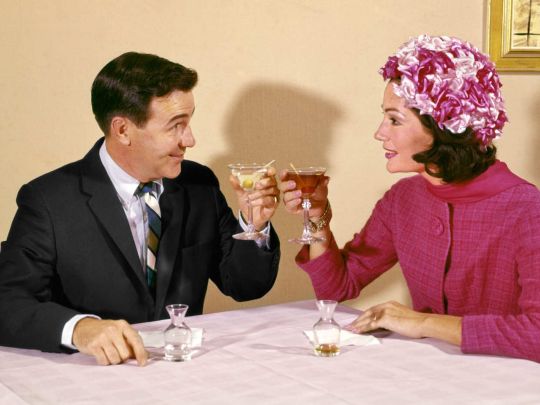
H. Armstrong Roberts/ClassicStock/Getty Images
The best shakers, strainers, bar spoons, jiggers, and more, from the Strategist
So you finally found the bar cart of your dreams, and you’ve loaded it up with your favorite liquor. While those are two very important steps to curating an at-home bar, to really make your setup recall that of your favorite watering hole, you’re going to want to add some barware and cocktail equipment. But that can be an intimidating task, especially if you’ve had more experience drinking cocktails than making them. The good news is that you don’t have to spend a lot of money. “Most people in their home bar really don’t need that many tools,” advises Joaquín Simó, a partner at New York City’s Pouring Ribbons who was named Tales of the Cocktail’s American Bartender of the Year in 2012. “I say you start with the absolute basics and concentrate on the things that you like to use.”
If you’re in a pinch, Martin Hudak, a bartender at Maybe Sammy, says you can always use tools you may already have on hand: “For your shaken cocktails, you can use empty jam jars or a thermos flask. For measuring, spoons and cups, and for stirring, any spoon or back of a wooden ladle.” But Stacey Swenson, the head bartender at Dante (which currently holds the No. 1 spot on the World’s 50 Best Bars list), notes that if you’re going to put stuff on display, you might want gear that’s both practical and stylish. “You want something that’s functional and also something that’s pretty,” she says. “If you’re putting it on your bar cart, you kind of put on a show for your guests.” With the help of Simó, Hudak, Swenson, and 28 other experts, we’ve put together the below list of essential gear for any cocktail-lover’s home bar.
Editor’s note: If you want to support service industry workers who have been impacted by the coronavirus closures, you can donate to the Restaurant Workers’ Community Foundation, which has set up a COVID-19 Crisis Relief Fund, or One Fair Wage, which has set up an Emergency Coronavirus Tipped and Service Worker Support Fund. We’ve also linked to any initiatives the businesses mentioned in this story have set up to support themselves amid the coronavirus pandemic.
Shakers
Best Overall Shaker

Cocktail Kingdom Koriko Weighted Shaking Tin Set
According to Simó, all shakers “technically do the same thing, and there are very cheap and very nice versions,” so there’s really no superior option when it comes to function. That said, many professional bartenders use Boston-style shakers, which are basically two cups that fit into each other and form a tight seal to keep liquid from splashing all over you. “If you want to look like a bartender at Death & Co. or PDT, and you want the same kit, then you’re probably going to go metal-on-metal,” or “tin-on-tin,” Simó notes. Six of our experts recommend these weighted tin-on-tin shakers — which come in a range of finishes, including copper and silver — from Cocktail Kingdom, a brand that nearly every bartender we spoke to praised for its durable, well-designed barware. Grand Army’s beverage director, Brendan Biggins, and head bartender, Robby Dow, call this “the gold standard” of shaking tins. “Behind the bar, there’s almost nothing worse than shaker tins that don’t seal well or don’t separate easily,” explains Krissy Harris, the beverage director and owner of Jungle Bird in Chelsea. “The Koriko Weighted Shaking tins seal perfectly every time and easily release,” she says. And because they’re weighted, they’re less likely to fall over and spill.
Best shaker for beginners
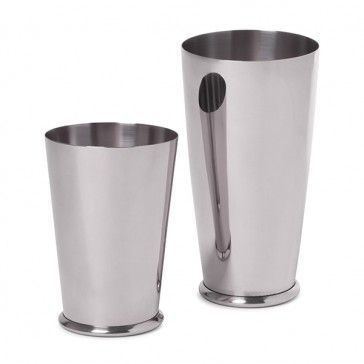
Cocktail Kingdom Leopold Weighted Shaking Tins Set
While most bartenders use Cocktail Kingdom’s Koriko tins, bartender Tim Cooper, who is also the head of brand advocacy for Fords Gin, says that the Leopold shaker is his favorite. “In my experience, the tins are easier to separate than the Koriko’s and feel a touch lighter, as well,” he says. “They’re simply more efficient,” adds Cooper, which is why he says this is a great option for the at-home bartender who’s not well versed on using shaker tins.
Best shaker with a built-in strainer
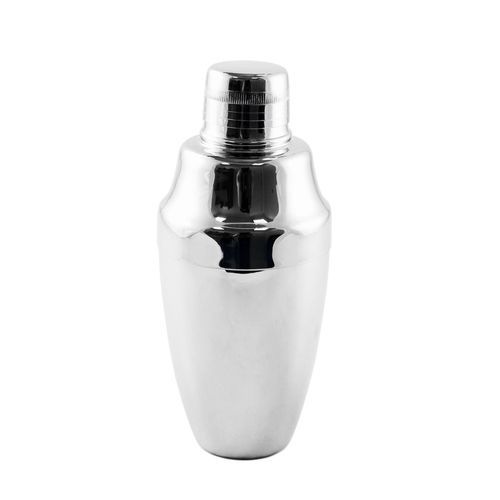
Yukiwa Stainless Steel Cobbler Cocktail Shaker
For some people, a two-piece setup like the above shakers might be tricky to use comfortably. “Say you’re a petite female — if you have very small hands, then maybe using a Boston-style shaker may be a little harder,” explains Simó. In that case, a cobbler shaker may be the better choice, because it’s smaller than a Boston-style shaker and thus easier to hold. The other convenient part of a cobbler-style shaker is that the strainer is already built into the lid, so you don’t necessarily have to spring for an additional tool. Karen Lin, a certified sommelier, sake expert, and the executive general manager of Tsukimi, suggests this shaker from Japanese barware brand Yukiwa. “The steel is very sturdy, and the shape fits perfectly in my hands,” she says. “It is also designed well so you can take it apart easily to clean.”
Mixing glasses
Best overall mixing glass
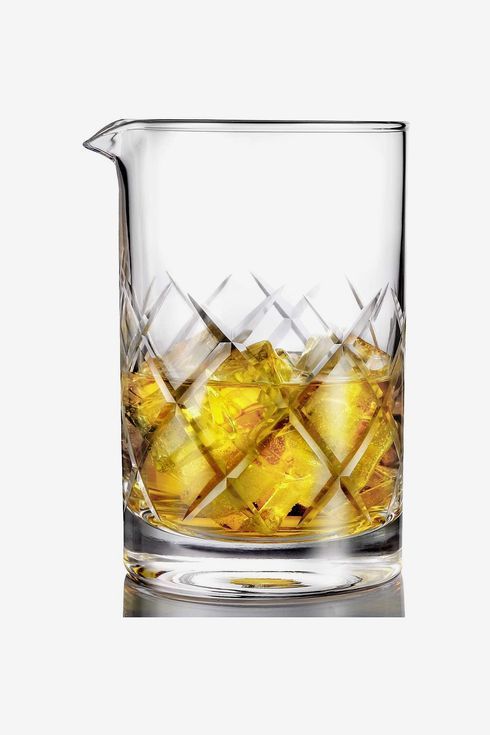
Hiware Professional Cocktail Mixing Glass
You know how James Bond always ordered his martinis shaken, not stirred? Well, if you were to ignore Mr. Bond’s order and make a stirred martini — or any other stirred cocktail, like a Negroni or a Manhattan — you’d set aside the shaker to use a mixing beaker instead. A mixing beaker is essentially a large vessel in which you dump your liquors and mix your drink. And though you can purchase handsome crystal ones for hundreds of dollars, both Simó and Swenson agree that they’re kind of superfluous for a basic bar kit. “I don’t think you should spend any more than $25 on a mixing glass,” says Swenson. Harris agrees, saying that since they are the most broken item behind the bar, you should stick to a well-priced option like this mixing glass from Hiware that “doesn’t have a seam, so it’s stronger and very attractive.”
Best nontraditional mixing glass

Bodum Replacement Beaker French Press, Replacement 12 Oz Clear Glass
One of Simó’s hacks to getting a glass mixing beaker for not that much money is to use the glass piece from a French press, which is something else you might already own. If you want a dedicated one for your bar cart (that could serve as a backup for your French press), he says you can buy a replacement glass like this one, which has a capacity that is particularly useful if you’re making drinks for a lot of people. “I generally will take one or two of the big guys with me when I’m doing events, because then I can stir up five drinks in one, and it’s really convenient,” Simó explains.
Best Pitcher

My Vintage Antique Shop Retro Martini Pitcher
According to Paul McGee, a co-owner of Lost Lake in Chicago, “finding vintage martini pitchers is very easy, and they are perfect for making large batches of cocktails.” Plus, they’ll look more visually striking on your bar cart. This one is even pretty enough to use as a vase when it’s not filled with punch. The photo shows the pitcher next to a strainer, but you’re only getting the pitcher for the price shown.
Bar Spoons
Best Japanese-style bar spoon
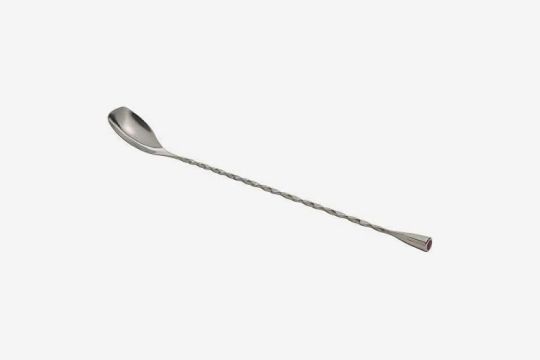
Twisted Bar Spoon by Modern Mixologist
If you’re making a stirred drink, a mixing or bar spoon is also necessary. “Three basic styles exist: the American bar spoon has a twisted handle and, usually, a plastic cap on the end, the European bar spoon has a flat muddler/crusher, and the Japanese bar spoon is heavier, with a weighted teardrop shape opposite the bowl,” explains Joe Palminteri, the director of food and beverage at Hamilton Hotel’s Via Sophia and Society. None of our experts recommended specific American-style bar spoons, but Simó told us that one of his favorite Japanese-style spoons is this one made by bartender Tony Abou-Ganim’s Modern Mixologist brand. “It’s got a really nice, deep bowl to it, which means you’re able to measure a nice, level teaspoon” without searching through your drawers, according to him. Simó continues, “The little top part of it has a nice little weight to it, but it’s not too bulky. So it gives you a really nice balance as you’re moving the mixing spoon around,” making your job a little easier.
Best European-style bar spoon
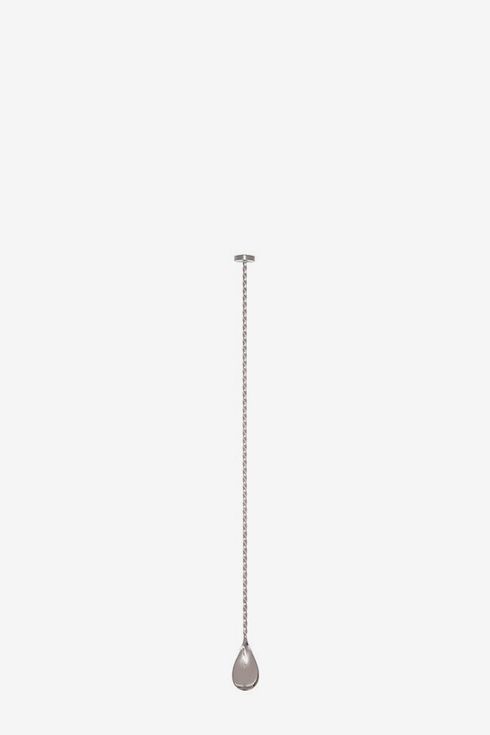
Cocktail Kingdom Muddler Barspoon, Silver-Plated
Should your at-home bartending require a lot of muddling, Swenson recommends getting a European-style spoon like this, which he says will still allow you to stir while eliminating the need to buy a dedicated muddler. “You can actually use the top of the spoon to crush a sugar cube if you wanted to for your old-fashioned. I have one of those, so I don’t have to have two tools; I’ve got both of them right there.”
Strainers
Best overall strainer

Cocktail Kingdom Buswell 4-Prong Hawthorne Strainer
You don’t necessarily need a strainer if you’re using a cobbler shaker, since it’s already got a strainer built into the lid. But if you’re using a Boston-style shaker, you should get what’s called a Hawthorne strainer to make sure the ice you used to chill your drink doesn’t end up in your glass and dilute the cocktail. Three experts recommend this one, including Lynnette Marrero, the beverage director of Llama Inn and Llama-San and the co-founder of Speed Rack, who says it’s her absolute favorite because “it is light and easy to clutch and close correctly.” If you choose to buy this Hawthorne strainer, Simó also recommends getting “the replacement springs that Cocktail Kingdom sells,” telling us they’re a good way to give a worn-out strainer a face-lift. “They’re really, really nice and tight, and you can generally slip them into any Hawthorne strainer that you have.”
Best less expensive strainer
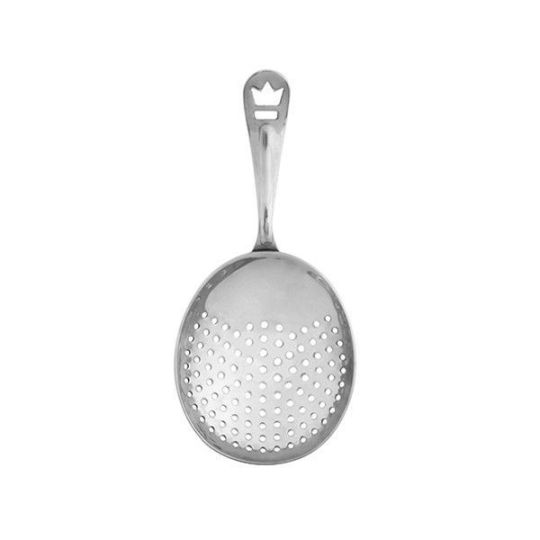
Cocktail Kingdom Julep Strainer
A slightly less expensive strainer is this Cocktail Kingdom julep strainer that three of our experts — bartender Random Ward; Padraig Confrey, the beverage director at Grupo Gitano; and Harris — also recommend. Generally, julep strainers will offer a better fit than Hawthorne strainers if you’re using a mixing glass to make your drinks. According to Cohen, a julep strainer can work equally well in the kitchen, because it “doubles as an ice scoop if needed, too.”
Jiggers
Best overall jigger
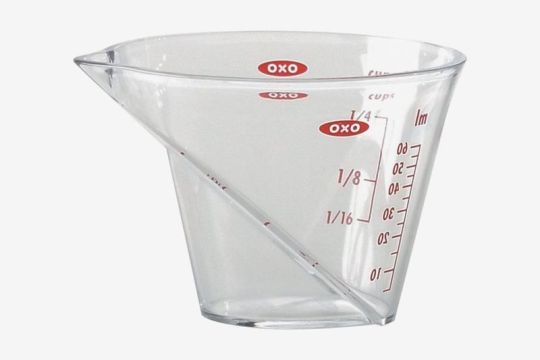
OXO Good Grips Angled Measuring Cup, Mini, Clear
A jigger is what you use to measure the liquor into the shaker or mixing glass. A hyperfunctional, albeit nontraditional-looking, option is the mini measuring cup from OXO. “I know some bartenders, including the ones at Drink in Boston, one of the best bars in the country, swear by those graduated OXO ones because they love the ability to read them from both the sides and the top,” explains Simó. “You can measure in tablespoons or ounces or milliliters, and it’s all on the same jigger.” Part-time bartender Jillian Norwick and Ward both love it too and keep the stainless steel version on hand (which looks a little nicer when left out). Noriwck adds that she’s in good company: “The peeps at Bon Appétit love it.”
Best stepped jigger
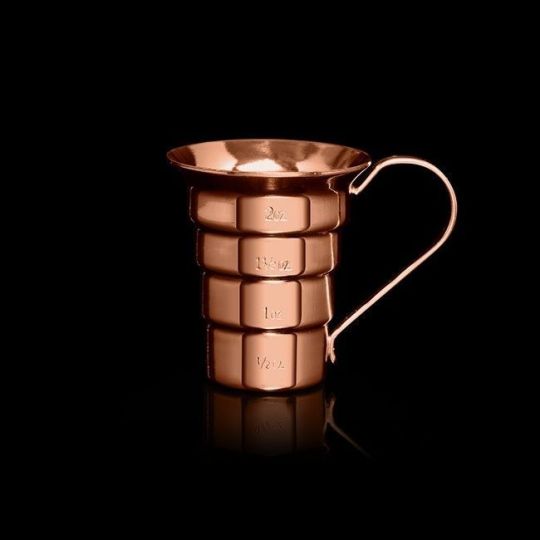
Cocktail Kingdom Stepped Copper Jigger
This fancy-looking jigger combines the functional appeal of the OXO measuring cup (it’s basically a cup that grows wider to accommodate different amounts of liquid) with the aesthetic appeal of a classic bar tool. It also makes measuring a snap: “This handy measuring tool is super-easy to use and enables the imbiber to essentially build all the ingredients of a drink in one go,” says Confrey.
Best traditional jigger

Viking Japanese-Style Jigger
If you’re going for a more classic look but still want something practical, Simó recommends this double-sided metal jigger that has a one-ounce cup on one side and a two-ounce cup on the other. The one-ounce side on this strainer also has a half- and three-quarter-ounce lines etched into it to make it even more precise. “That gives you a lot of wiggle room” and will allow you to measure for most basic cocktails, Simó says. “From there, you really just have to learn what a quarter-ounce looks like in there, and you’re pretty much good to go.”
Best Leopold jigger
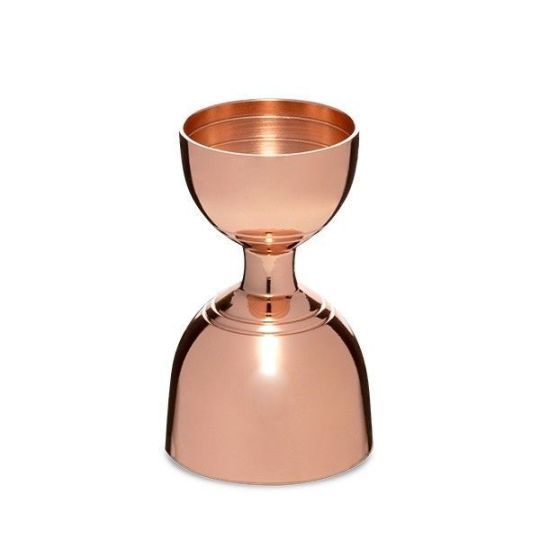
Cocktail Kingdom Leopold Jigger
Biggens, Dowe, and Swenson prefer a Leopold jigger, which has a unique bell shape (with one bell holding an ounce, and the other two ounces) as well as lines etched on the inside marking both quarter- and half-ounces. “They’re really easy to hold and they have some weight to them,” Swenson adds. “Somebody who’s not really experienced using a jigger is going to be fine with something with a little bit more weight to it. And they look cool.”
Glassware
Best collins/highball glasses

Cocktail Kingdom Buswell Collins Glass, 12-Ounces
Though it’s easy to want to get a different type of glass for every type of drink you make, that’s really unnecessary when you’re first starting out. According to Simó, “You can make 90 percent of drinks into a good, all-purpose cocktail glass like a rocks or a collins glass.” (While this section contains our bartenders’ favorite glasses, if you want to shop around, you can find most of these styles at various price points in our list of the best drinking glasses.) A collins — or highball — glass is the one that looks like a chimney, and generally you’re looking for something that’s about 12 ounces, like these collins glasses from bartender-favorite brand Cocktail Kingdom. “You don’t want a 16-ounce Collins glass because you’re going to be hammered after your second Tom Collins,” advises Simó.
Best rocks glasses
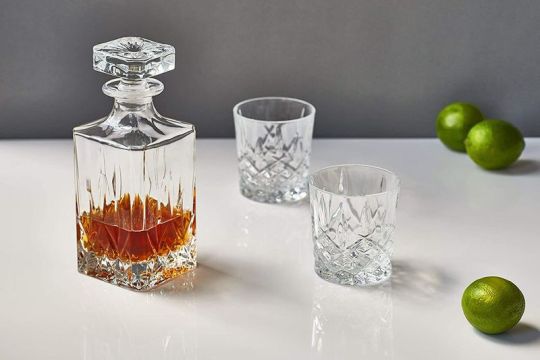
Marquis by Waterford Markham Double Old Fashioned Glasses
For a rocks glass, Simó says the ideal size is between eight and ten ounces. “That’s enough where you could put a decent-size chunk of ice in there if you like making the fancy ice,” he explains. This set of four rocks glasses recommended by Theo Lieberman, the beverage director of 232 Bleecker, is slightly larger at 11 ounces each (more room for fancy ice), and he says they’re durable, machine-washable, and look good to boot. “No one likes taking all the time to make a cocktail and then just putting in a boring glass,” he says.
Best coupe glasses

Cocktail Kingdom Leopold Coupe Glass
If you’re looking for glassware beyond the basic collins and rocks glasses, Swenson suggests adding some coupe, or bell-shaped, glasses to your setup, because they’re more forgiving than a V-shaped martini glass (which, she adds, are “super out of style” these days). “The curve on a coupe holds the liquid in a little bit more, so if you get jostled, the liquid is more likely to slosh within the glass but stay in the glass,” Swenson explains. “They’re sleek, they’re smaller, and they look a lot classier than a martini glass.” A coupe glass should be somewhere between six and eight-and-a-half ounces, advises Simó. Nate Fishman, the brand ambassador for Santera Tequila and a bartender at Liquor Lab, likes these six-ounce coupe glasses, telling us that, in his opinion, “everything tastes better out of a coupe glass.”
Bar-tool sets
Best overall bar-tool set

Cocktail Kingdom Essential Cocktail Set
Instead of shopping à la carte, Johnny Swet, the owner of Brooklyn’s Grand Republic Cocktail Club and a bar consultant for Jimmy at the James and The Skylark, says that Cocktail Kingdom sells many of the above tools as part of this set. It includes a spouted mixing glass, weighted metal shaker tins, Japanese jiggers, bar spoons, and a Hawthorne strainer (or everything you need to make a drink at home). If you want to be really fancy, you can even get it in copper or gold.
Best less expensive bar-tool set
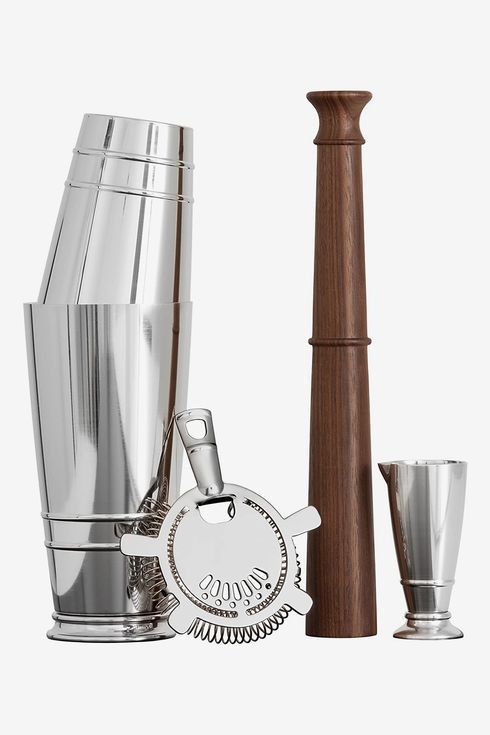
Crafthouse by Fortessa Professional Barware by Charles Joly Gift Set
For a more affordable set, Marrero suggests this really “nice at-home barware set that includes a shaker, muddler, strainer, and jigger.”
More expert-approved gear for your at-home bar
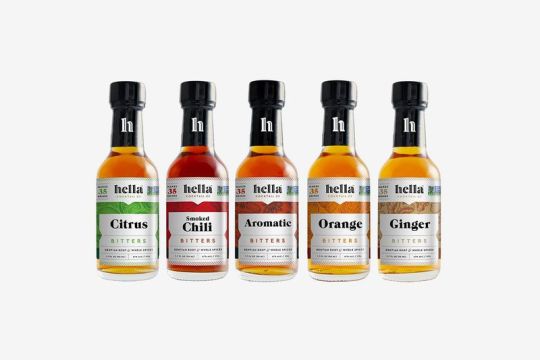
Hella Cocktail Co. Cocktail Bitters Variety Pack
“The world of bitters is massive, and there is so much variety available on the market now,” says Four Seasons Hotel New York beverage director Cara Maldonado. To stock up on several profiles of bitters without breaking the bank on larger individual bottles, Cooper says to try this variety pack, which includes aromatic, citrus, orange, smoked chili, and ginger bitters. “It’s great for the budding home bartender that they can use to experiment with.” Linden Pride, a co-owner of Dante, is also a fan of stocking a bar cart with several types of bitters like those found in this set.
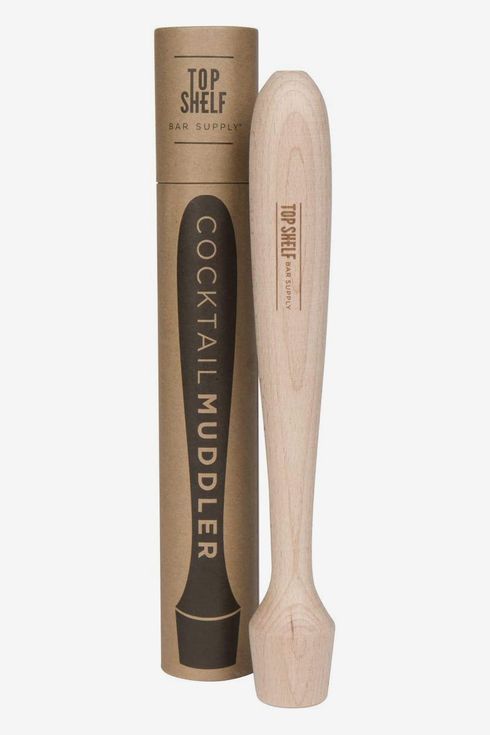
Top Shelf Bar Supply Extra Long Cocktail Muddler
If you do want a proper muddler (not just a muddling spoon) to make drinks that require sugar cubes, herbs, or fruit (like old fashioneds, mojitos, or Brambles), Harris prefers an old-school, wood style. “As long as it’s rinsed and left to dry, it shouldn’t crack,” she says.
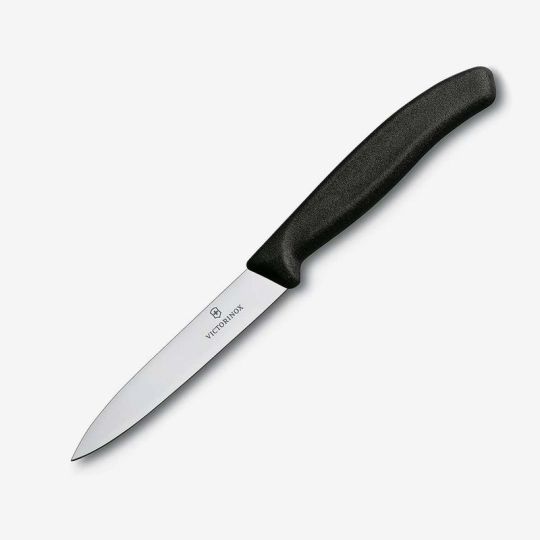
Victorinox Swiss Classic Paring Knife
According to cocktail expert and global brand ambassador for Absolut Elyx Gareth Evans, “When you’re making drinks for friends, remember that the first sip is with the eye, and this is where a good, sharp knife comes in to make sure your garnishes look fresh.” He suggests this non-serrated paring knife from Victorinox, which he says “is the bartender staple around the world.”

Rösle Stainless Steel Crosswise Swivel Peeler
Though there are some tools that are specifically designed to make garnishes, most home bartenders will be set with a vegetable peeler. Rösle peelers, though more expensive, are “insanely sharp — they are built like tanks,” says Simó, “and they will last for a long time. So if aesthetics matter, those are really, really spectacular, and I would highly advise one.” If aesthetics don’t matter, Biggins says a regular vegetable peeler works just as well, naming the simple, Strategist-approved vegetable peelers from Swiss kitchenware company Kuhn Rikon as a favorite (Norwick and Dowe are both fans too).

GBO Amber Boston Round with Black Glass Dropper
Kris Peterson of Chicago’s Mordecai and Hush Money calls these glass droppers “indispensable to cocktails,” because they allow you to make drinks with more precision. “Dasher bottles can sometimes be clumsy and inconsistent,” he explains, adding that droppers are especially useful with ingredients like crème de violette or maraschino or Chartreuse that can take over a drink without a light touch.
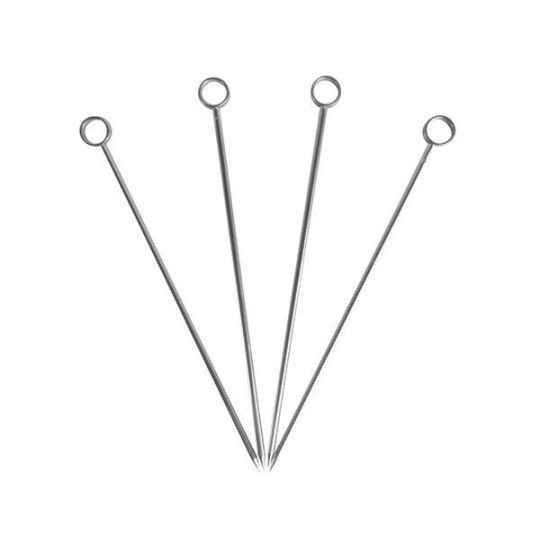
Cocktail Kingdom Stainless Steel Cocktail Picks
For garnishes, Paula November, the event vice president of Reed Exhibitions and Bar Convent Brooklyn, loves these sleek-looking, reusable picks for topping off a cocktail.
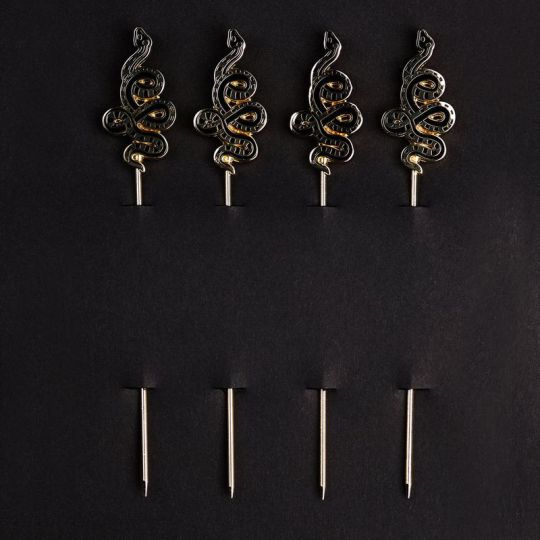
Love and Victory Snake Cocktail Picks
If you’re looking for a pick with personality (that isn’t an umbrella), Katipai Richardson-Wilson, the owner of Gowanus bar Dirty Precious, “uses these stylish snake cocktail picks if I’m showing off.” She promises that they’re “guaranteed to kick even the most delicious cocktail up a notch.”

PERLII Ice Cube Trays Large Silicone
“At home, I just have the two-by-two ice-cube trays,” says Swenson. “I don’t stress with making them perfectly clear, but if you want to take the time to do that, that’s totally fine.” According to Simó, basically any style of ice-cube tray you have at home will likely yield better ice than you’d get at an actual bar. “For the most part, you will make better ice in your home freezer using even standard ice molds,” he says. That’s because most commercial ice machines produce ice that “is designed to stack on each other and take up a lot of room, but has so much surface area that it melts really quickly” and dilutes your drink. If you’re looking to add a bartender-approved ice tray to your freezer, Lieberman says that these molds are “easy to use and clean,” and make 2.5x2.5-inch cubes that are great for any cocktail or just whiskey on the rocks.

Secret Warehouse Skull Ice Cubes
Those who want ice with a bit of flair should consider these skull-shaped ice cubes that Rob Dietrich, the master distiller at Blackened American Whiskey, uses at home. “The large surface melts slow, offering a less diluted beverage,” he says. His other tip: Use filtered water when making your ice to get the best taste.
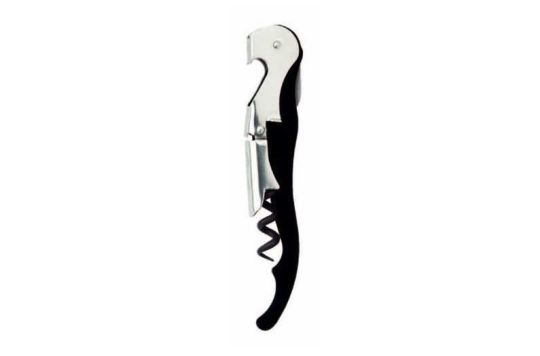
Pulltex Corkscrew, Black
“A good wine key is invaluable,” says Simó, though you don’t necessarily need to spend much money on one. He recommends getting one with a serrated blade (to take the foil off of the bottle) and coated coil, because it’ll go into the cork more smoothly. “The kind that have the hinged little portion that you can get halfway through the pull and then re-lock it to get the other half in, those are very forgiving because it gives you two different angles at which to get the cork out perfectly vertically,” he adds.

Repour Wine Saver
Should you be eyeing an expensive Coravin to preserve any wine bottles you uncork at home, Matt Crafton, a winemaker at Chateau Montelena, says this RePour wine saver does good a job at keeping your unfinished bottles fresh for a fraction of the cost. “They’re inexpensive, dead simple, and effective.”

Chef’n FreshForce Citrus Juicer
“The only way to get good lemon and lime juice is to take a small, round, fresh green or yellow thing, cut it through the equator, and then put it into a juicer and ream it and use it that day,” says Simó. “You can’t use it the next day. It gets really bitter and oxidized and gross.” That’s why he says having a handheld juicer is so important if you’re trying to up your home-cocktail game. Ivy Mix — the owner of Leyenda in Brooklyn, a co-founder of the all-female bartending competition Speed Rack, and the author of the forthcoming book Spirits of Latin America — agrees: “Having a fantastic juicer on hand is a must.” Biggins and Dowe say this handheld juicer is the “best of the best,” because it’s efficient, sturdy, and gets the most juice out of your citrus. If you want something more powerful, Brian Evans, the director of bars at Sunday Hospitality, says an “easy-to-operate beast” like the Breville electric juicer will up your mixology game a notch by allowing you to juice vegetables and fruits, instead of just simple citrus.
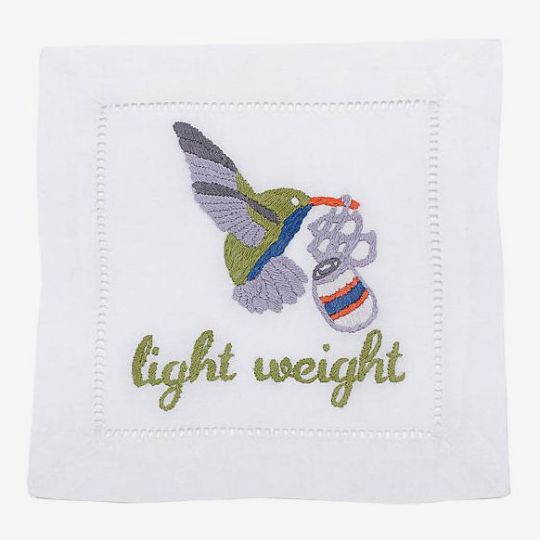
August Morgan Lightweight Cocktail Napkins
“For useful décor, I love to serve drinks on vintage cocktail napkins,” says Allen Katz, a co-founder of New York Distilling Company. “They are a great escape and a conversation piece at the same time.” Vintage linens (or anything) are typically one-of, and Katz did not name a favorite style or seller, so if you’re looking for a napkin that doubles as a conversation starter, might we suggest these embroidered ones from August Morgan, which contributor Chloe Malle says should appeal to “shameless pun-thusiasts.”

Cocktail Codex
Just like you keep a coffee table book in the living room and a cookbook in the kitchen, you can display a cocktail book on your bar cart. Evans calls this “one of the most invaluable cocktail books ever released,” as well as a “treasure trove like no other.” Cocktail Codex is a James Beard Award–winning book that “lays out a wide spectrum of techniques, flavor pairings, and spirits knowledge that really speak to the professional mixologist as effectively as the casual home bartender,” he explains.
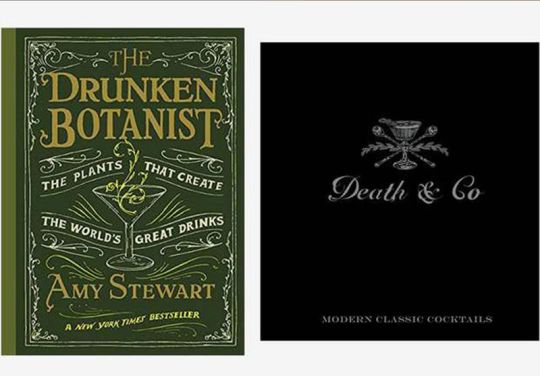
“There are endless books on the subject of cocktails, and I want them all,” says Maldonado. She has a rotation of “informative and beautiful” tomes that she keeps on her own home bar, including Death & Co and The Drunken Botanist as well as Cocktail Codex. “Friends love thumbing through them” while she entertains, she adds.
Vox Media has affiliate partnerships. These do not influence editorial content, though Vox Media may earn commissions for products purchased via affiliate links. For more information, see our ethics policy.
from Eater - All https://ift.tt/2yM8WEd
https://ift.tt/39ULQIj

H. Armstrong Roberts/ClassicStock/Getty Images
The best shakers, strainers, bar spoons, jiggers, and more, from the Strategist
So you finally found the bar cart of your dreams, and you’ve loaded it up with your favorite liquor. While those are two very important steps to curating an at-home bar, to really make your setup recall that of your favorite watering hole, you’re going to want to add some barware and cocktail equipment. But that can be an intimidating task, especially if you’ve had more experience drinking cocktails than making them. The good news is that you don’t have to spend a lot of money. “Most people in their home bar really don’t need that many tools,” advises Joaquín Simó, a partner at New York City’s Pouring Ribbons who was named Tales of the Cocktail’s American Bartender of the Year in 2012. “I say you start with the absolute basics and concentrate on the things that you like to use.”
If you’re in a pinch, Martin Hudak, a bartender at Maybe Sammy, says you can always use tools you may already have on hand: “For your shaken cocktails, you can use empty jam jars or a thermos flask. For measuring, spoons and cups, and for stirring, any spoon or back of a wooden ladle.” But Stacey Swenson, the head bartender at Dante (which currently holds the No. 1 spot on the World’s 50 Best Bars list), notes that if you’re going to put stuff on display, you might want gear that’s both practical and stylish. “You want something that’s functional and also something that’s pretty,” she says. “If you’re putting it on your bar cart, you kind of put on a show for your guests.” With the help of Simó, Hudak, Swenson, and 28 other experts, we’ve put together the below list of essential gear for any cocktail-lover’s home bar.
Editor’s note: If you want to support service industry workers who have been impacted by the coronavirus closures, you can donate to the Restaurant Workers’ Community Foundation, which has set up a COVID-19 Crisis Relief Fund, or One Fair Wage, which has set up an Emergency Coronavirus Tipped and Service Worker Support Fund. We’ve also linked to any initiatives the businesses mentioned in this story have set up to support themselves amid the coronavirus pandemic.
Shakers
Best Overall Shaker

Cocktail Kingdom Koriko Weighted Shaking Tin Set
According to Simó, all shakers “technically do the same thing, and there are very cheap and very nice versions,” so there’s really no superior option when it comes to function. That said, many professional bartenders use Boston-style shakers, which are basically two cups that fit into each other and form a tight seal to keep liquid from splashing all over you. “If you want to look like a bartender at Death & Co. or PDT, and you want the same kit, then you’re probably going to go metal-on-metal,” or “tin-on-tin,” Simó notes. Six of our experts recommend these weighted tin-on-tin shakers — which come in a range of finishes, including copper and silver — from Cocktail Kingdom, a brand that nearly every bartender we spoke to praised for its durable, well-designed barware. Grand Army’s beverage director, Brendan Biggins, and head bartender, Robby Dow, call this “the gold standard” of shaking tins. “Behind the bar, there’s almost nothing worse than shaker tins that don’t seal well or don’t separate easily,” explains Krissy Harris, the beverage director and owner of Jungle Bird in Chelsea. “The Koriko Weighted Shaking tins seal perfectly every time and easily release,” she says. And because they’re weighted, they’re less likely to fall over and spill.
Best shaker for beginners

Cocktail Kingdom Leopold Weighted Shaking Tins Set
While most bartenders use Cocktail Kingdom’s Koriko tins, bartender Tim Cooper, who is also the head of brand advocacy for Fords Gin, says that the Leopold shaker is his favorite. “In my experience, the tins are easier to separate than the Koriko’s and feel a touch lighter, as well,” he says. “They’re simply more efficient,” adds Cooper, which is why he says this is a great option for the at-home bartender who’s not well versed on using shaker tins.
Best shaker with a built-in strainer

Yukiwa Stainless Steel Cobbler Cocktail Shaker
For some people, a two-piece setup like the above shakers might be tricky to use comfortably. “Say you’re a petite female — if you have very small hands, then maybe using a Boston-style shaker may be a little harder,” explains Simó. In that case, a cobbler shaker may be the better choice, because it’s smaller than a Boston-style shaker and thus easier to hold. The other convenient part of a cobbler-style shaker is that the strainer is already built into the lid, so you don’t necessarily have to spring for an additional tool. Karen Lin, a certified sommelier, sake expert, and the executive general manager of Tsukimi, suggests this shaker from Japanese barware brand Yukiwa. “The steel is very sturdy, and the shape fits perfectly in my hands,” she says. “It is also designed well so you can take it apart easily to clean.”
Mixing glasses
Best overall mixing glass

Hiware Professional Cocktail Mixing Glass
You know how James Bond always ordered his martinis shaken, not stirred? Well, if you were to ignore Mr. Bond’s order and make a stirred martini — or any other stirred cocktail, like a Negroni or a Manhattan — you’d set aside the shaker to use a mixing beaker instead. A mixing beaker is essentially a large vessel in which you dump your liquors and mix your drink. And though you can purchase handsome crystal ones for hundreds of dollars, both Simó and Swenson agree that they’re kind of superfluous for a basic bar kit. “I don’t think you should spend any more than $25 on a mixing glass,” says Swenson. Harris agrees, saying that since they are the most broken item behind the bar, you should stick to a well-priced option like this mixing glass from Hiware that “doesn’t have a seam, so it’s stronger and very attractive.”
Best nontraditional mixing glass

Bodum Replacement Beaker French Press, Replacement 12 Oz Clear Glass
One of Simó’s hacks to getting a glass mixing beaker for not that much money is to use the glass piece from a French press, which is something else you might already own. If you want a dedicated one for your bar cart (that could serve as a backup for your French press), he says you can buy a replacement glass like this one, which has a capacity that is particularly useful if you’re making drinks for a lot of people. “I generally will take one or two of the big guys with me when I’m doing events, because then I can stir up five drinks in one, and it’s really convenient,” Simó explains.
Best Pitcher

My Vintage Antique Shop Retro Martini Pitcher
According to Paul McGee, a co-owner of Lost Lake in Chicago, “finding vintage martini pitchers is very easy, and they are perfect for making large batches of cocktails.” Plus, they’ll look more visually striking on your bar cart. This one is even pretty enough to use as a vase when it’s not filled with punch. The photo shows the pitcher next to a strainer, but you’re only getting the pitcher for the price shown.
Bar Spoons
Best Japanese-style bar spoon

Twisted Bar Spoon by Modern Mixologist
If you’re making a stirred drink, a mixing or bar spoon is also necessary. “Three basic styles exist: the American bar spoon has a twisted handle and, usually, a plastic cap on the end, the European bar spoon has a flat muddler/crusher, and the Japanese bar spoon is heavier, with a weighted teardrop shape opposite the bowl,” explains Joe Palminteri, the director of food and beverage at Hamilton Hotel’s Via Sophia and Society. None of our experts recommended specific American-style bar spoons, but Simó told us that one of his favorite Japanese-style spoons is this one made by bartender Tony Abou-Ganim’s Modern Mixologist brand. “It’s got a really nice, deep bowl to it, which means you’re able to measure a nice, level teaspoon” without searching through your drawers, according to him. Simó continues, “The little top part of it has a nice little weight to it, but it’s not too bulky. So it gives you a really nice balance as you’re moving the mixing spoon around,” making your job a little easier.
Best European-style bar spoon

Cocktail Kingdom Muddler Barspoon, Silver-Plated
Should your at-home bartending require a lot of muddling, Swenson recommends getting a European-style spoon like this, which he says will still allow you to stir while eliminating the need to buy a dedicated muddler. “You can actually use the top of the spoon to crush a sugar cube if you wanted to for your old-fashioned. I have one of those, so I don’t have to have two tools; I’ve got both of them right there.”
Strainers
Best overall strainer

Cocktail Kingdom Buswell 4-Prong Hawthorne Strainer
You don’t necessarily need a strainer if you’re using a cobbler shaker, since it’s already got a strainer built into the lid. But if you’re using a Boston-style shaker, you should get what’s called a Hawthorne strainer to make sure the ice you used to chill your drink doesn’t end up in your glass and dilute the cocktail. Three experts recommend this one, including Lynnette Marrero, the beverage director of Llama Inn and Llama-San and the co-founder of Speed Rack, who says it’s her absolute favorite because “it is light and easy to clutch and close correctly.” If you choose to buy this Hawthorne strainer, Simó also recommends getting “the replacement springs that Cocktail Kingdom sells,” telling us they’re a good way to give a worn-out strainer a face-lift. “They’re really, really nice and tight, and you can generally slip them into any Hawthorne strainer that you have.”
Best less expensive strainer

Cocktail Kingdom Julep Strainer
A slightly less expensive strainer is this Cocktail Kingdom julep strainer that three of our experts — bartender Random Ward; Padraig Confrey, the beverage director at Grupo Gitano; and Harris — also recommend. Generally, julep strainers will offer a better fit than Hawthorne strainers if you’re using a mixing glass to make your drinks. According to Cohen, a julep strainer can work equally well in the kitchen, because it “doubles as an ice scoop if needed, too.”
Jiggers
Best overall jigger

OXO Good Grips Angled Measuring Cup, Mini, Clear
A jigger is what you use to measure the liquor into the shaker or mixing glass. A hyperfunctional, albeit nontraditional-looking, option is the mini measuring cup from OXO. “I know some bartenders, including the ones at Drink in Boston, one of the best bars in the country, swear by those graduated OXO ones because they love the ability to read them from both the sides and the top,” explains Simó. “You can measure in tablespoons or ounces or milliliters, and it’s all on the same jigger.” Part-time bartender Jillian Norwick and Ward both love it too and keep the stainless steel version on hand (which looks a little nicer when left out). Noriwck adds that she’s in good company: “The peeps at Bon Appétit love it.”
Best stepped jigger

Cocktail Kingdom Stepped Copper Jigger
This fancy-looking jigger combines the functional appeal of the OXO measuring cup (it’s basically a cup that grows wider to accommodate different amounts of liquid) with the aesthetic appeal of a classic bar tool. It also makes measuring a snap: “This handy measuring tool is super-easy to use and enables the imbiber to essentially build all the ingredients of a drink in one go,” says Confrey.
Best traditional jigger

Viking Japanese-Style Jigger
If you’re going for a more classic look but still want something practical, Simó recommends this double-sided metal jigger that has a one-ounce cup on one side and a two-ounce cup on the other. The one-ounce side on this strainer also has a half- and three-quarter-ounce lines etched into it to make it even more precise. “That gives you a lot of wiggle room” and will allow you to measure for most basic cocktails, Simó says. “From there, you really just have to learn what a quarter-ounce looks like in there, and you’re pretty much good to go.”
Best Leopold jigger

Cocktail Kingdom Leopold Jigger
Biggens, Dowe, and Swenson prefer a Leopold jigger, which has a unique bell shape (with one bell holding an ounce, and the other two ounces) as well as lines etched on the inside marking both quarter- and half-ounces. “They’re really easy to hold and they have some weight to them,” Swenson adds. “Somebody who’s not really experienced using a jigger is going to be fine with something with a little bit more weight to it. And they look cool.”
Glassware
Best collins/highball glasses

Cocktail Kingdom Buswell Collins Glass, 12-Ounces
Though it’s easy to want to get a different type of glass for every type of drink you make, that’s really unnecessary when you’re first starting out. According to Simó, “You can make 90 percent of drinks into a good, all-purpose cocktail glass like a rocks or a collins glass.” (While this section contains our bartenders’ favorite glasses, if you want to shop around, you can find most of these styles at various price points in our list of the best drinking glasses.) A collins — or highball — glass is the one that looks like a chimney, and generally you’re looking for something that’s about 12 ounces, like these collins glasses from bartender-favorite brand Cocktail Kingdom. “You don’t want a 16-ounce Collins glass because you’re going to be hammered after your second Tom Collins,” advises Simó.
Best rocks glasses

Marquis by Waterford Markham Double Old Fashioned Glasses
For a rocks glass, Simó says the ideal size is between eight and ten ounces. “That’s enough where you could put a decent-size chunk of ice in there if you like making the fancy ice,” he explains. This set of four rocks glasses recommended by Theo Lieberman, the beverage director of 232 Bleecker, is slightly larger at 11 ounces each (more room for fancy ice), and he says they’re durable, machine-washable, and look good to boot. “No one likes taking all the time to make a cocktail and then just putting in a boring glass,” he says.
Best coupe glasses

Cocktail Kingdom Leopold Coupe Glass
If you’re looking for glassware beyond the basic collins and rocks glasses, Swenson suggests adding some coupe, or bell-shaped, glasses to your setup, because they’re more forgiving than a V-shaped martini glass (which, she adds, are “super out of style” these days). “The curve on a coupe holds the liquid in a little bit more, so if you get jostled, the liquid is more likely to slosh within the glass but stay in the glass,” Swenson explains. “They’re sleek, they’re smaller, and they look a lot classier than a martini glass.” A coupe glass should be somewhere between six and eight-and-a-half ounces, advises Simó. Nate Fishman, the brand ambassador for Santera Tequila and a bartender at Liquor Lab, likes these six-ounce coupe glasses, telling us that, in his opinion, “everything tastes better out of a coupe glass.”
Bar-tool sets
Best overall bar-tool set

Cocktail Kingdom Essential Cocktail Set
Instead of shopping à la carte, Johnny Swet, the owner of Brooklyn’s Grand Republic Cocktail Club and a bar consultant for Jimmy at the James and The Skylark, says that Cocktail Kingdom sells many of the above tools as part of this set. It includes a spouted mixing glass, weighted metal shaker tins, Japanese jiggers, bar spoons, and a Hawthorne strainer (or everything you need to make a drink at home). If you want to be really fancy, you can even get it in copper or gold.
Best less expensive bar-tool set

Crafthouse by Fortessa Professional Barware by Charles Joly Gift Set
For a more affordable set, Marrero suggests this really “nice at-home barware set that includes a shaker, muddler, strainer, and jigger.”
More expert-approved gear for your at-home bar

Hella Cocktail Co. Cocktail Bitters Variety Pack
“The world of bitters is massive, and there is so much variety available on the market now,” says Four Seasons Hotel New York beverage director Cara Maldonado. To stock up on several profiles of bitters without breaking the bank on larger individual bottles, Cooper says to try this variety pack, which includes aromatic, citrus, orange, smoked chili, and ginger bitters. “It’s great for the budding home bartender that they can use to experiment with.” Linden Pride, a co-owner of Dante, is also a fan of stocking a bar cart with several types of bitters like those found in this set.

Top Shelf Bar Supply Extra Long Cocktail Muddler
If you do want a proper muddler (not just a muddling spoon) to make drinks that require sugar cubes, herbs, or fruit (like old fashioneds, mojitos, or Brambles), Harris prefers an old-school, wood style. “As long as it’s rinsed and left to dry, it shouldn’t crack,” she says.

Victorinox Swiss Classic Paring Knife
According to cocktail expert and global brand ambassador for Absolut Elyx Gareth Evans, “When you’re making drinks for friends, remember that the first sip is with the eye, and this is where a good, sharp knife comes in to make sure your garnishes look fresh.” He suggests this non-serrated paring knife from Victorinox, which he says “is the bartender staple around the world.”

Rösle Stainless Steel Crosswise Swivel Peeler
Though there are some tools that are specifically designed to make garnishes, most home bartenders will be set with a vegetable peeler. Rösle peelers, though more expensive, are “insanely sharp — they are built like tanks,” says Simó, “and they will last for a long time. So if aesthetics matter, those are really, really spectacular, and I would highly advise one.” If aesthetics don’t matter, Biggins says a regular vegetable peeler works just as well, naming the simple, Strategist-approved vegetable peelers from Swiss kitchenware company Kuhn Rikon as a favorite (Norwick and Dowe are both fans too).

GBO Amber Boston Round with Black Glass Dropper
Kris Peterson of Chicago’s Mordecai and Hush Money calls these glass droppers “indispensable to cocktails,” because they allow you to make drinks with more precision. “Dasher bottles can sometimes be clumsy and inconsistent,” he explains, adding that droppers are especially useful with ingredients like crème de violette or maraschino or Chartreuse that can take over a drink without a light touch.

Cocktail Kingdom Stainless Steel Cocktail Picks
For garnishes, Paula November, the event vice president of Reed Exhibitions and Bar Convent Brooklyn, loves these sleek-looking, reusable picks for topping off a cocktail.

Love and Victory Snake Cocktail Picks
If you’re looking for a pick with personality (that isn’t an umbrella), Katipai Richardson-Wilson, the owner of Gowanus bar Dirty Precious, “uses these stylish snake cocktail picks if I’m showing off.” She promises that they’re “guaranteed to kick even the most delicious cocktail up a notch.”

PERLII Ice Cube Trays Large Silicone
“At home, I just have the two-by-two ice-cube trays,” says Swenson. “I don’t stress with making them perfectly clear, but if you want to take the time to do that, that’s totally fine.” According to Simó, basically any style of ice-cube tray you have at home will likely yield better ice than you’d get at an actual bar. “For the most part, you will make better ice in your home freezer using even standard ice molds,” he says. That’s because most commercial ice machines produce ice that “is designed to stack on each other and take up a lot of room, but has so much surface area that it melts really quickly” and dilutes your drink. If you’re looking to add a bartender-approved ice tray to your freezer, Lieberman says that these molds are “easy to use and clean,” and make 2.5x2.5-inch cubes that are great for any cocktail or just whiskey on the rocks.

Secret Warehouse Skull Ice Cubes
Those who want ice with a bit of flair should consider these skull-shaped ice cubes that Rob Dietrich, the master distiller at Blackened American Whiskey, uses at home. “The large surface melts slow, offering a less diluted beverage,” he says. His other tip: Use filtered water when making your ice to get the best taste.

Pulltex Corkscrew, Black
“A good wine key is invaluable,” says Simó, though you don’t necessarily need to spend much money on one. He recommends getting one with a serrated blade (to take the foil off of the bottle) and coated coil, because it’ll go into the cork more smoothly. “The kind that have the hinged little portion that you can get halfway through the pull and then re-lock it to get the other half in, those are very forgiving because it gives you two different angles at which to get the cork out perfectly vertically,” he adds.

Repour Wine Saver
Should you be eyeing an expensive Coravin to preserve any wine bottles you uncork at home, Matt Crafton, a winemaker at Chateau Montelena, says this RePour wine saver does good a job at keeping your unfinished bottles fresh for a fraction of the cost. “They’re inexpensive, dead simple, and effective.”

Chef’n FreshForce Citrus Juicer
“The only way to get good lemon and lime juice is to take a small, round, fresh green or yellow thing, cut it through the equator, and then put it into a juicer and ream it and use it that day,” says Simó. “You can’t use it the next day. It gets really bitter and oxidized and gross.” That’s why he says having a handheld juicer is so important if you’re trying to up your home-cocktail game. Ivy Mix — the owner of Leyenda in Brooklyn, a co-founder of the all-female bartending competition Speed Rack, and the author of the forthcoming book Spirits of Latin America — agrees: “Having a fantastic juicer on hand is a must.” Biggins and Dowe say this handheld juicer is the “best of the best,” because it’s efficient, sturdy, and gets the most juice out of your citrus. If you want something more powerful, Brian Evans, the director of bars at Sunday Hospitality, says an “easy-to-operate beast” like the Breville electric juicer will up your mixology game a notch by allowing you to juice vegetables and fruits, instead of just simple citrus.

August Morgan Lightweight Cocktail Napkins
“For useful décor, I love to serve drinks on vintage cocktail napkins,” says Allen Katz, a co-founder of New York Distilling Company. “They are a great escape and a conversation piece at the same time.” Vintage linens (or anything) are typically one-of, and Katz did not name a favorite style or seller, so if you’re looking for a napkin that doubles as a conversation starter, might we suggest these embroidered ones from August Morgan, which contributor Chloe Malle says should appeal to “shameless pun-thusiasts.”

Cocktail Codex
Just like you keep a coffee table book in the living room and a cookbook in the kitchen, you can display a cocktail book on your bar cart. Evans calls this “one of the most invaluable cocktail books ever released,” as well as a “treasure trove like no other.” Cocktail Codex is a James Beard Award–winning book that “lays out a wide spectrum of techniques, flavor pairings, and spirits knowledge that really speak to the professional mixologist as effectively as the casual home bartender,” he explains.

“There are endless books on the subject of cocktails, and I want them all,” says Maldonado. She has a rotation of “informative and beautiful” tomes that she keeps on her own home bar, including Death & Co and The Drunken Botanist as well as Cocktail Codex. “Friends love thumbing through them” while she entertains, she adds.
Vox Media has affiliate partnerships. These do not influence editorial content, though Vox Media may earn commissions for products purchased via affiliate links. For more information, see our ethics policy.
from Eater - All https://ift.tt/2yM8WEd
via Blogger https://ift.tt/39ULQbh
1 note
·
View note
Photo


Saint of the Day – 29 July – St Martha – sister of St Lazarus and St Mary of Bethany. Friend of Jesus, and hostess to him in her house. May have been part of an early mission to France. Died – c.80 of natural causes. Patronage – butlers• Congregation of Martha and Mary (founded in 1979)• cooks (proclaimed on 1 July 1963 by Pope Paul VI)• dieticians • domestic servants• homemakers • hotel-keepers• housemaids• housewives• innkeepers (proclaimed on 1 July 1963 by Pope Paul VI) • laundry workers • maids• manservants • servants• servers• single laywomen• travellers• Villajoyosa, Spain (chosen after a flash flood saved the village from Moorish invaders on her feast day in 1538). Attributes – • broom (referring to being a home maker)• dragon• keys (referring to keeping the home) • with a holy water sprinkler or holy water pot• ladle (reference to her home-making, cooking, etc.).
One of the most precious things in life is to have a home where you can go at any time and find people who accept, love, and understand you. Jesus found such a home in Bethany, at the house of a woman named Martha. She welcomed Him and served Him and they developed a special bond of friendship. One of these visits has ever remained dear to Christian memory. On that occasion Martha, busily serving the Master, asked Him to persuade Mary to help her. Without in any way reproaching Martha, Jesus explained to her that certain souls, called by God, should choose a better part still — the primary duty of listening to Him and contemplating Him.

Martha lived with her sister Mary. Like many other pairs of sisters, these two women were different in personality. Martha was energetic and outspoken, while Mary was quiet and reflective. Jesus loved both of them and appreciated the gifts that each one had.
The Gospel of Luke records that once, when Jesus was visiting, Martha prepared the meal while Mary sat talking to their visitor. Martha complained that Jesus should tell Mary to help her. Jesus said that because Martha was worrying so much about the work, she did not have time to enjoy being with Him and listening to His words.







(via AnaStpaul – Breathing Catholic)
16 notes
·
View notes
Text
From the Strategist Everything You Need to Stock an at-Home Bar (Minus Booze), According to Bartenders (1) added to Google Docs
From the Strategist Everything You Need to Stock an at-Home Bar (Minus Booze), According to Bartenders (1)
H. Armstrong Roberts/ClassicStock/Getty Images
The best shakers, strainers, bar spoons, jiggers, and more, from the Strategist
So you finally found the bar cart of your dreams, and you’ve loaded it up with your favorite liquor. While those are two very important steps to curating an at-home bar, to really make your setup recall that of your favorite watering hole, you’re going to want to add some barware and cocktail equipment. But that can be an intimidating task, especially if you’ve had more experience drinking cocktails than making them. The good news is that you don’t have to spend a lot of money. “Most people in their home bar really don’t need that many tools,” advises Joaquín Simó, a partner at New York City’s Pouring Ribbons who was named Tales of the Cocktail’s American Bartender of the Year in 2012. “I say you start with the absolute basics and concentrate on the things that you like to use.”
If you’re in a pinch, Martin Hudak, a bartender at Maybe Sammy, says you can always use tools you may already have on hand: “For your shaken cocktails, you can use empty jam jars or a thermos flask. For measuring, spoons and cups, and for stirring, any spoon or back of a wooden ladle.” But Stacey Swenson, the head bartender at Dante (which currently holds the No. 1 spot on the World’s 50 Best Bars list), notes that if you’re going to put stuff on display, you might want gear that’s both practical and stylish. “You want something that’s functional and also something that’s pretty,” she says. “If you’re putting it on your bar cart, you kind of put on a show for your guests.” With the help of Simó, Hudak, Swenson, and 28 other experts, we’ve put together the below list of essential gear for any cocktail-lover’s home bar.
Editor’s note: If you want to support service industry workers who have been impacted by the coronavirus closures, you can donate to the Restaurant Workers’ Community Foundation, which has set up a COVID-19 Crisis Relief Fund, or One Fair Wage, which has set up an Emergency Coronavirus Tipped and Service Worker Support Fund. We’ve also linked to any initiatives the businesses mentioned in this story have set up to support themselves amid the coronavirus pandemic.
Shakers Best Overall Shaker Cocktail Kingdom Koriko Weighted Shaking Tin Set
According to Simó, all shakers “technically do the same thing, and there are very cheap and very nice versions,” so there’s really no superior option when it comes to function. That said, many professional bartenders use Boston-style shakers, which are basically two cups that fit into each other and form a tight seal to keep liquid from splashing all over you. “If you want to look like a bartender at Death & Co. or PDT, and you want the same kit, then you’re probably going to go metal-on-metal,” or “tin-on-tin,” Simó notes. Six of our experts recommend these weighted tin-on-tin shakers — which come in a range of finishes, including copper and silver — from Cocktail Kingdom, a brand that nearly every bartender we spoke to praised for its durable, well-designed barware. Grand Army’s beverage director, Brendan Biggins, and head bartender, Robby Dow, call this “the gold standard” of shaking tins. “Behind the bar, there’s almost nothing worse than shaker tins that don’t seal well or don’t separate easily,” explains Krissy Harris, the beverage director and owner of Jungle Bird in Chelsea. “The Koriko Weighted Shaking tins seal perfectly every time and easily release,” she says. And because they’re weighted, they’re less likely to fall over and spill.
Best shaker for beginners Cocktail Kingdom Leopold Weighted Shaking Tins Set
While most bartenders use Cocktail Kingdom’s Koriko tins, bartender Tim Cooper, who is also the head of brand advocacy for Fords Gin, says that the Leopold shaker is his favorite. “In my experience, the tins are easier to separate than the Koriko’s and feel a touch lighter, as well,” he says. “They’re simply more efficient,” adds Cooper, which is why he says this is a great option for the at-home bartender who’s not well versed on using shaker tins.
Best shaker with a built-in strainer Yukiwa Stainless Steel Cobbler Cocktail Shaker
For some people, a two-piece setup like the above shakers might be tricky to use comfortably. “Say you’re a petite female — if you have very small hands, then maybe using a Boston-style shaker may be a little harder,” explains Simó. In that case, a cobbler shaker may be the better choice, because it’s smaller than a Boston-style shaker and thus easier to hold. The other convenient part of a cobbler-style shaker is that the strainer is already built into the lid, so you don’t necessarily have to spring for an additional tool. Karen Lin, a certified sommelier, sake expert, and the executive general manager of Tsukimi, suggests this shaker from Japanese barware brand Yukiwa. “The steel is very sturdy, and the shape fits perfectly in my hands,” she says. “It is also designed well so you can take it apart easily to clean.”
Mixing glasses Best overall mixing glass Hiware Professional Cocktail Mixing Glass
You know how James Bond always ordered his martinis shaken, not stirred? Well, if you were to ignore Mr. Bond’s order and make a stirred martini — or any other stirred cocktail, like a Negroni or a Manhattan — you’d set aside the shaker to use a mixing beaker instead. A mixing beaker is essentially a large vessel in which you dump your liquors and mix your drink. And though you can purchase handsome crystal ones for hundreds of dollars, both Simó and Swenson agree that they’re kind of superfluous for a basic bar kit. “I don’t think you should spend any more than $25 on a mixing glass,” says Swenson. Harris agrees, saying that since they are the most broken item behind the bar, you should stick to a well-priced option like this mixing glass from Hiware that “doesn’t have a seam, so it’s stronger and very attractive.”
Best nontraditional mixing glass Bodum Replacement Beaker French Press, Replacement 12 Oz Clear Glass
One of Simó’s hacks to getting a glass mixing beaker for not that much money is to use the glass piece from a French press, which is something else you might already own. If you want a dedicated one for your bar cart (that could serve as a backup for your French press), he says you can buy a replacement glass like this one, which has a capacity that is particularly useful if you’re making drinks for a lot of people. “I generally will take one or two of the big guys with me when I’m doing events, because then I can stir up five drinks in one, and it’s really convenient,” Simó explains.
Best Pitcher My Vintage Antique Shop Retro Martini Pitcher
According to Paul McGee, a co-owner of Lost Lake in Chicago, “finding vintage martini pitchers is very easy, and they are perfect for making large batches of cocktails.” Plus, they’ll look more visually striking on your bar cart. This one is even pretty enough to use as a vase when it’s not filled with punch. The photo shows the pitcher next to a strainer, but you’re only getting the pitcher for the price shown.
Bar Spoons Best Japanese-style bar spoon Twisted Bar Spoon by Modern Mixologist
If you’re making a stirred drink, a mixing or bar spoon is also necessary. “Three basic styles exist: the American bar spoon has a twisted handle and, usually, a plastic cap on the end, the European bar spoon has a flat muddler/crusher, and the Japanese bar spoon is heavier, with a weighted teardrop shape opposite the bowl,” explains Joe Palminteri, the director of food and beverage at Hamilton Hotel’s Via Sophia and Society. None of our experts recommended specific American-style bar spoons, but Simó told us that one of his favorite Japanese-style spoons is this one made by bartender Tony Abou-Ganim’s Modern Mixologist brand. “It’s got a really nice, deep bowl to it, which means you’re able to measure a nice, level teaspoon” without searching through your drawers, according to him. Simó continues, “The little top part of it has a nice little weight to it, but it’s not too bulky. So it gives you a really nice balance as you’re moving the mixing spoon around,” making your job a little easier.
Best European-style bar spoon Cocktail Kingdom Muddler Barspoon, Silver-Plated
Should your at-home bartending require a lot of muddling, Swenson recommends getting a European-style spoon like this, which he says will still allow you to stir while eliminating the need to buy a dedicated muddler. “You can actually use the top of the spoon to crush a sugar cube if you wanted to for your old-fashioned. I have one of those, so I don’t have to have two tools; I’ve got both of them right there.”
Strainers Best overall strainer Cocktail Kingdom Buswell 4-Prong Hawthorne Strainer
You don’t necessarily need a strainer if you’re using a cobbler shaker, since it’s already got a strainer built into the lid. But if you’re using a Boston-style shaker, you should get what’s called a Hawthorne strainer to make sure the ice you used to chill your drink doesn’t end up in your glass and dilute the cocktail. Three experts recommend this one, including Lynnette Marrero, the beverage director of Llama Inn and Llama-San and the co-founder of Speed Rack, who says it’s her absolute favorite because “it is light and easy to clutch and close correctly.” If you choose to buy this Hawthorne strainer, Simó also recommends getting “the replacement springs that Cocktail Kingdom sells,” telling us they’re a good way to give a worn-out strainer a face-lift. “They’re really, really nice and tight, and you can generally slip them into any Hawthorne strainer that you have.”
Best less expensive strainer Cocktail Kingdom Julep Strainer
A slightly less expensive strainer is this Cocktail Kingdom julep strainer that three of our experts — bartender Random Ward; Padraig Confrey, the beverage director at Grupo Gitano; and Harris — also recommend. Generally, julep strainers will offer a better fit than Hawthorne strainers if you’re using a mixing glass to make your drinks. According to Cohen, a julep strainer can work equally well in the kitchen, because it “doubles as an ice scoop if needed, too.”
Jiggers Best overall jigger OXO Good Grips Angled Measuring Cup, Mini, Clear
A jigger is what you use to measure the liquor into the shaker or mixing glass. A hyperfunctional, albeit nontraditional-looking, option is the mini measuring cup from OXO. “I know some bartenders, including the ones at Drink in Boston, one of the best bars in the country, swear by those graduated OXO ones because they love the ability to read them from both the sides and the top,” explains Simó. “You can measure in tablespoons or ounces or milliliters, and it’s all on the same jigger.” Part-time bartender Jillian Norwick and Ward both love it too and keep the stainless steel version on hand (which looks a little nicer when left out). Noriwck adds that she’s in good company: “The peeps at Bon Appétit love it.”
Best stepped jigger Cocktail Kingdom Stepped Copper Jigger
This fancy-looking jigger combines the functional appeal of the OXO measuring cup (it’s basically a cup that grows wider to accommodate different amounts of liquid) with the aesthetic appeal of a classic bar tool. It also makes measuring a snap: “This handy measuring tool is super-easy to use and enables the imbiber to essentially build all the ingredients of a drink in one go,” says Confrey.
Best traditional jigger Viking Japanese-Style Jigger
If you’re going for a more classic look but still want something practical, Simó recommends this double-sided metal jigger that has a one-ounce cup on one side and a two-ounce cup on the other. The one-ounce side on this strainer also has a half- and three-quarter-ounce lines etched into it to make it even more precise. “That gives you a lot of wiggle room” and will allow you to measure for most basic cocktails, Simó says. “From there, you really just have to learn what a quarter-ounce looks like in there, and you’re pretty much good to go.”
Best Leopold jigger Cocktail Kingdom Leopold Jigger
Biggens, Dowe, and Swenson prefer a Leopold jigger, which has a unique bell shape (with one bell holding an ounce, and the other two ounces) as well as lines etched on the inside marking both quarter- and half-ounces. “They’re really easy to hold and they have some weight to them,” Swenson adds. “Somebody who’s not really experienced using a jigger is going to be fine with something with a little bit more weight to it. And they look cool.”
Glassware Best collins/highball glasses Cocktail Kingdom Buswell Collins Glass, 12-Ounces
Though it’s easy to want to get a different type of glass for every type of drink you make, that’s really unnecessary when you’re first starting out. According to Simó, “You can make 90 percent of drinks into a good, all-purpose cocktail glass like a rocks or a collins glass.” (While this section contains our bartenders’ favorite glasses, if you want to shop around, you can find most of these styles at various price points in our list of the best drinking glasses.) A collins — or highball — glass is the one that looks like a chimney, and generally you’re looking for something that’s about 12 ounces, like these collins glasses from bartender-favorite brand Cocktail Kingdom. “You don’t want a 16-ounce Collins glass because you’re going to be hammered after your second Tom Collins,” advises Simó.
Best rocks glasses Marquis by Waterford Markham Double Old Fashioned Glasses
For a rocks glass, Simó says the ideal size is between eight and ten ounces. “That’s enough where you could put a decent-size chunk of ice in there if you like making the fancy ice,” he explains. This set of four rocks glasses recommended by Theo Lieberman, the beverage director of 232 Bleecker, is slightly larger at 11 ounces each (more room for fancy ice), and he says they’re durable, machine-washable, and look good to boot. “No one likes taking all the time to make a cocktail and then just putting in a boring glass,” he says.
Best coupe glasses Cocktail Kingdom Leopold Coupe Glass
If you’re looking for glassware beyond the basic collins and rocks glasses, Swenson suggests adding some coupe, or bell-shaped, glasses to your setup, because they’re more forgiving than a V-shaped martini glass (which, she adds, are “super out of style” these days). “The curve on a coupe holds the liquid in a little bit more, so if you get jostled, the liquid is more likely to slosh within the glass but stay in the glass,” Swenson explains. “They’re sleek, they’re smaller, and they look a lot classier than a martini glass.” A coupe glass should be somewhere between six and eight-and-a-half ounces, advises Simó. Nate Fishman, the brand ambassador for Santera Tequila and a bartender at Liquor Lab, likes these six-ounce coupe glasses, telling us that, in his opinion, “everything tastes better out of a coupe glass.”
Bar-tool sets Best overall bar-tool set Cocktail Kingdom Essential Cocktail Set
Instead of shopping à la carte, Johnny Swet, the owner of Brooklyn’s Grand Republic Cocktail Club and a bar consultant for Jimmy at the James and The Skylark, says that Cocktail Kingdom sells many of the above tools as part of this set. It includes a spouted mixing glass, weighted metal shaker tins, Japanese jiggers, bar spoons, and a Hawthorne strainer (or everything you need to make a drink at home). If you want to be really fancy, you can even get it in copper or gold.
Best less expensive bar-tool set Crafthouse by Fortessa Professional Barware by Charles Joly Gift Set
For a more affordable set, Marrero suggests this really “nice at-home barware set that includes a shaker, muddler, strainer, and jigger.”
More expert-approved gear for your at-home bar Hella Cocktail Co. Cocktail Bitters Variety Pack
“The world of bitters is massive, and there is so much variety available on the market now,” says Four Seasons Hotel New York beverage director Cara Maldonado. To stock up on several profiles of bitters without breaking the bank on larger individual bottles, Cooper says to try this variety pack, which includes aromatic, citrus, orange, smoked chili, and ginger bitters. “It’s great for the budding home bartender that they can use to experiment with.” Linden Pride, a co-owner of Dante, is also a fan of stocking a bar cart with several types of bitters like those found in this set.
Top Shelf Bar Supply Extra Long Cocktail Muddler
If you do want a proper muddler (not just a muddling spoon) to make drinks that require sugar cubes, herbs, or fruit (like old fashioneds, mojitos, or Brambles), Harris prefers an old-school, wood style. “As long as it’s rinsed and left to dry, it shouldn’t crack,” she says.
Victorinox Swiss Classic Paring Knife
According to cocktail expert and global brand ambassador for Absolut Elyx Gareth Evans, “When you’re making drinks for friends, remember that the first sip is with the eye, and this is where a good, sharp knife comes in to make sure your garnishes look fresh.” He suggests this non-serrated paring knife from Victorinox, which he says “is the bartender staple around the world.”
Rösle Stainless Steel Crosswise Swivel Peeler
Though there are some tools that are specifically designed to make garnishes, most home bartenders will be set with a vegetable peeler. Rösle peelers, though more expensive, are “insanely sharp — they are built like tanks,” says Simó, “and they will last for a long time. So if aesthetics matter, those are really, really spectacular, and I would highly advise one.” If aesthetics don’t matter, Biggins says a regular vegetable peeler works just as well, naming the simple, Strategist-approved vegetable peelers from Swiss kitchenware company Kuhn Rikon as a favorite (Norwick and Dowe are both fans too).
GBO Amber Boston Round with Black Glass Dropper
Kris Peterson of Chicago’s Mordecai and Hush Money calls these glass droppers “indispensable to cocktails,” because they allow you to make drinks with more precision. “Dasher bottles can sometimes be clumsy and inconsistent,” he explains, adding that droppers are especially useful with ingredients like crème de violette or maraschino or Chartreuse that can take over a drink without a light touch.
Cocktail Kingdom Stainless Steel Cocktail Picks
For garnishes, Paula November, the event vice president of Reed Exhibitions and Bar Convent Brooklyn, loves these sleek-looking, reusable picks for topping off a cocktail.
Love and Victory Snake Cocktail Picks
If you’re looking for a pick with personality (that isn’t an umbrella), Katipai Richardson-Wilson, the owner of Gowanus bar Dirty Precious, “uses these stylish snake cocktail picks if I’m showing off.” She promises that they’re “guaranteed to kick even the most delicious cocktail up a notch.”
PERLII Ice Cube Trays Large Silicone
“At home, I just have the two-by-two ice-cube trays,” says Swenson. “I don’t stress with making them perfectly clear, but if you want to take the time to do that, that’s totally fine.” According to Simó, basically any style of ice-cube tray you have at home will likely yield better ice than you’d get at an actual bar. “For the most part, you will make better ice in your home freezer using even standard ice molds,” he says. That’s because most commercial ice machines produce ice that “is designed to stack on each other and take up a lot of room, but has so much surface area that it melts really quickly” and dilutes your drink. If you’re looking to add a bartender-approved ice tray to your freezer, Lieberman says that these molds are “easy to use and clean,” and make 2.5x2.5-inch cubes that are great for any cocktail or just whiskey on the rocks.
Secret Warehouse Skull Ice Cubes
Those who want ice with a bit of flair should consider these skull-shaped ice cubes that Rob Dietrich, the master distiller at Blackened American Whiskey, uses at home. “The large surface melts slow, offering a less diluted beverage,” he says. His other tip: Use filtered water when making your ice to get the best taste.
Pulltex Corkscrew, Black
“A good wine key is invaluable,” says Simó, though you don’t necessarily need to spend much money on one. He recommends getting one with a serrated blade (to take the foil off of the bottle) and coated coil, because it’ll go into the cork more smoothly. “The kind that have the hinged little portion that you can get halfway through the pull and then re-lock it to get the other half in, those are very forgiving because it gives you two different angles at which to get the cork out perfectly vertically,” he adds.
Repour Wine Saver
Should you be eyeing an expensive Coravin to preserve any wine bottles you uncork at home, Matt Crafton, a winemaker at Chateau Montelena, says this RePour wine saver does good a job at keeping your unfinished bottles fresh for a fraction of the cost. “They’re inexpensive, dead simple, and effective.”
Chef’n FreshForce Citrus Juicer
“The only way to get good lemon and lime juice is to take a small, round, fresh green or yellow thing, cut it through the equator, and then put it into a juicer and ream it and use it that day,” says Simó. “You can’t use it the next day. It gets really bitter and oxidized and gross.” That’s why he says having a handheld juicer is so important if you’re trying to up your home-cocktail game. Ivy Mix — the owner of Leyenda in Brooklyn, a co-founder of the all-female bartending competition Speed Rack, and the author of the forthcoming book Spirits of Latin America — agrees: “Having a fantastic juicer on hand is a must.” Biggins and Dowe say this handheld juicer is the “best of the best,” because it’s efficient, sturdy, and gets the most juice out of your citrus. If you want something more powerful, Brian Evans, the director of bars at Sunday Hospitality, says an “easy-to-operate beast” like the Breville electric juicer will up your mixology game a notch by allowing you to juice vegetables and fruits, instead of just simple citrus.
August Morgan Lightweight Cocktail Napkins
“For useful décor, I love to serve drinks on vintage cocktail napkins,” says Allen Katz, a co-founder of New York Distilling Company. “They are a great escape and a conversation piece at the same time.” Vintage linens (or anything) are typically one-of, and Katz did not name a favorite style or seller, so if you’re looking for a napkin that doubles as a conversation starter, might we suggest these embroidered ones from August Morgan, which contributor Chloe Malle says should appeal to “shameless pun-thusiasts.”
Cocktail Codex
Just like you keep a coffee table book in the living room and a cookbook in the kitchen, you can display a cocktail book on your bar cart. Evans calls this “one of the most invaluable cocktail books ever released,” as well as a “treasure trove like no other.” Cocktail Codex is a James Beard Award–winning book that “lays out a wide spectrum of techniques, flavor pairings, and spirits knowledge that really speak to the professional mixologist as effectively as the casual home bartender,” he explains.
“There are endless books on the subject of cocktails, and I want them all,” says Maldonado. She has a rotation of “informative and beautiful” tomes that she keeps on her own home bar, including Death & Co and The Drunken Botanist as well as Cocktail Codex. “Friends love thumbing through them” while she entertains, she adds.
Vox Media has affiliate partnerships. These do not influence editorial content, though Vox Media may earn commissions for products purchased via affiliate links. For more information, see our ethics policy.
via Eater - All https://www.eater.com/2020/4/9/21214234/how-to-stock-at-home-bar-according-to-bartenders-best-tools
Created April 10, 2020 at 04:42AM
/huong sen
View Google Doc Nhà hàng Hương Sen chuyên buffet hải sản cao cấp✅ Tổ chức tiệc cưới✅ Hội nghị, hội thảo✅ Tiệc lưu động✅ Sự kiện mang tầm cỡ quốc gia 52 Phố Miếu Đầm, Mễ Trì, Nam Từ Liêm, Hà Nội http://huongsen.vn/ 0904988999 http://huongsen.vn/to-chuc-tiec-hoi-nghi/ https://drive.google.com/drive/folders/1xa6sRugRZk4MDSyctcqusGYBv1lXYkrF
0 notes
Text
France on holiday: a day at the beach in Sanary-sur-Mer | Travel
Morning
On the southernFrench coast between Toulon and Marseille, Sanary-sur-Mer has always been a popular destination for boat-lovers and beach-goers and last year its market was voted the most beautiful in France.
Smoke from the roasting chickens spreads over the stalls of olives, lavender honey and trays of pickled garlic and on to the giant swordfish and tuna on the tiny metal counters on the harbour. I join the queue for cade, a spongy pancake made from chickpea flour, baked in the food truck’s wood-fired furnace, which has been a tradition in Sanary for more than 200 years.
Map of southern France
During summer weekends, owners of the town’s hundred or so pointus, brightlypainted wooden fishing boats, take people for free tours of the harbour and surrounding waters. It is organised by the Association des Pointus de Sanary, all wearing marinière striped jerseys.
Jean Luc Ercolani looks like a rebel. No marinière for him. He helps me into his boat and I see a tattoo of a kraken poking out from under his T-shirt sleeve. He tips his seafaring leather hat and we’re off towards the rust-coloured coastline.
Pointus taking passengers along the Sanary coast. Photograph: Jon Bryant
“I named the boat Serenità [serenity], which is my philosophy on life,” says Jean Luc. “She has an old soul. I used to have a motorised dinghy but I prefer the authenticity of the pointu. They were fishermen’s boats so are very stable: they had to go out in all weathers.” Jean-Luc’s pointu has a lovingly varnished teak deck and dates from the 1970s but others in the harbour were built in the early 1900s. “Sanary is proud of its pointus,” he says. “In December they cover the boats in fairy lights.”
Jean Luc Ercolani on his pointu, Serenita. Photograph: Jon Bryant
Back on shore, I wander along the port esplanade where Le Galion has already started dishing out moules frites and crêpes. Visitors are boarding a ferry to pastis baron Paul Ricard’s island Les Embiez, and the bright red Sanary Explorer, half-boat, half-submarine, takes trips to see the starfish, sea urchins and meadows of Neptune grass.
Afternoon
The walk to Portissol beach takes around 15 minutes, up the steep Montée de l’Oratoire to Notre-Dame de Pitié. The chapel was founded in 1560 and looked after by hermits who lit warning fires if there were Barbary pirates, the Duke of Savoy or a storm approaching.
Portissol beach. Photograph: Alamy
At the top of the hill is the Villa Baobab, home of the late scuba-diving pioneer and underwater film-maker Jacques Cousteau, who ended up in Sanary after fleeing the Nazis along with members of the German and Austrian literary scene, Thomas Mann, Joseph Roth, Klaus Mann and Stefan Zweig.
Portissol beach fills up early but is then abandoned at lunchtime as sunbathers head for the nearest beach restaurant, leaving a waffle pattern of towels on the grainy sand. A family waves me over. “We saw you on the boat this morning!” They look at each other and laugh, three generations sharing a beach towel. “You looked a bit green. I said to Pierre-Alain [her son], ‘Look at him gripping the sides!’” The Mistral wind can make things very choppy in Sanary-sur-Mer.
I walk along the Quai Sud, a walkway at the side of the beach where there’s a seawater lagoon reserved for children practising snorkelling, and, a little further on, a diving zone where buoyant adolescents are leaping backwards into the sea. At the far end of the rocks is a cove where the smokers, dogs and inflatable beach balls hang out, none of whom are allowed on the main plage.
Luna Penn, left, and Axel Zoellin from Ô Petit Monde. Photograph: Jon Bryant
Portissol has a thick hemline of washed-up Neptune grass between sand and sea. “It’s illegal to remove it now,” explains Axel Zoellin, who works at the beach restaurant Ô Petit Monde. The grass protects the beach. “It gets very busy here as the beach is sheltered from the wind and popular with families. We prefer to go swimming in the rocky creeks along the coast.”
Axel grew up nearby, like his co-worker Luna Penn, but they actually met in Australia. Un vrai petit monde. The trendy restaurant is a cabin of modern furniture and driftwood, open every day, even during the winter, with live music on Sundays and five guestrooms upstairs. “We can seat 200 people, but out of season, it’s just locals who come,” says Zoellin.
Evening
Hôtel de la Tour
Sanary’s 21m-high stone watchtower is the emblem of the town and stood there, isolated, from the middle of the 13th century until 1507 when local inhabitants were allowed to build homes attached to its base. It stays open until 9.30pm on summer weekends, so I climb up the stone stairs and ladders to its terrace, perfect for watching the sunset.
Dinner is at Hôtel de la Tour which has been run by the Mercier family since 1936. I have the fish soup and monkfish medallions but every other table has ordered the poisson en croûte de sel, a whole sea bass baked inside a mound of salt. Waiters crack open the salt crust with wooden mallets and ladle away the crystals, a theatrical excavation that serves two-three. My wife looks up from her scampi and we decide to be braver next time.
Sanary’s summer night market. Photograph: Jon Bryant
Midnight, back on the portside, the night market is coming to an end and a street performer finishes with Charles Trenet’s La Mer under the harbour’s palm trees. I take the late-night trip on the Sanary Explorer, whose underwater lights pick up the moray eels phytoplankton and wake up any fish who’d already turned in for the night in the Neptune grass.
• Hôtel de la Tour has doubles from €88 B&B; its restaurant serves a two-course lunchtime formule for €24. Ô Petit Monde on serves mains from €22
Looking for a holiday with a difference? Browse Guardian Holidays to see a range of fantastic trips
The post France on holiday: a day at the beach in Sanary-sur-Mer | Travel appeared first on Tripstations.
from Tripstations https://ift.tt/2MG4Gfk
via IFTTT
0 notes
Quote
H. Armstrong Roberts/ClassicStock/Getty Images
The best shakers, strainers, bar spoons, jiggers, and more, from the Strategist
So you finally found the bar cart of your dreams, and you’ve loaded it up with your favorite liquor. While those are two very important steps to curating an at-home bar, to really make your setup recall that of your favorite watering hole, you’re going to want to add some barware and cocktail equipment. But that can be an intimidating task, especially if you’ve had more experience drinking cocktails than making them. The good news is that you don’t have to spend a lot of money. “Most people in their home bar really don’t need that many tools,” advises Joaquín Simó, a partner at New York City’s Pouring Ribbons who was named Tales of the Cocktail’s American Bartender of the Year in 2012. “I say you start with the absolute basics and concentrate on the things that you like to use.”
If you’re in a pinch, Martin Hudak, a bartender at Maybe Sammy, says you can always use tools you may already have on hand: “For your shaken cocktails, you can use empty jam jars or a thermos flask. For measuring, spoons and cups, and for stirring, any spoon or back of a wooden ladle.” But Stacey Swenson, the head bartender at Dante (which currently holds the No. 1 spot on the World’s 50 Best Bars list), notes that if you’re going to put stuff on display, you might want gear that’s both practical and stylish. “You want something that’s functional and also something that’s pretty,” she says. “If you’re putting it on your bar cart, you kind of put on a show for your guests.” With the help of Simó, Hudak, Swenson, and 28 other experts, we’ve put together the below list of essential gear for any cocktail-lover’s home bar.
Editor’s note: If you want to support service industry workers who have been impacted by the coronavirus closures, you can donate to the Restaurant Workers’ Community Foundation, which has set up a COVID-19 Crisis Relief Fund, or One Fair Wage, which has set up an Emergency Coronavirus Tipped and Service Worker Support Fund. We’ve also linked to any initiatives the businesses mentioned in this story have set up to support themselves amid the coronavirus pandemic.
Shakers
Best Overall Shaker
Cocktail Kingdom Koriko Weighted Shaking Tin Set
According to Simó, all shakers “technically do the same thing, and there are very cheap and very nice versions,” so there’s really no superior option when it comes to function. That said, many professional bartenders use Boston-style shakers, which are basically two cups that fit into each other and form a tight seal to keep liquid from splashing all over you. “If you want to look like a bartender at Death & Co. or PDT, and you want the same kit, then you’re probably going to go metal-on-metal,” or “tin-on-tin,” Simó notes. Six of our experts recommend these weighted tin-on-tin shakers — which come in a range of finishes, including copper and silver — from Cocktail Kingdom, a brand that nearly every bartender we spoke to praised for its durable, well-designed barware. Grand Army’s beverage director, Brendan Biggins, and head bartender, Robby Dow, call this “the gold standard” of shaking tins. “Behind the bar, there’s almost nothing worse than shaker tins that don’t seal well or don’t separate easily,” explains Krissy Harris, the beverage director and owner of Jungle Bird in Chelsea. “The Koriko Weighted Shaking tins seal perfectly every time and easily release,” she says. And because they’re weighted, they’re less likely to fall over and spill.
Best shaker for beginners
Cocktail Kingdom Leopold Weighted Shaking Tins Set
While most bartenders use Cocktail Kingdom’s Koriko tins, bartender Tim Cooper, who is also the head of brand advocacy for Fords Gin, says that the Leopold shaker is his favorite. “In my experience, the tins are easier to separate than the Koriko’s and feel a touch lighter, as well,” he says. “They’re simply more efficient,” adds Cooper, which is why he says this is a great option for the at-home bartender who’s not well versed on using shaker tins.
Best shaker with a built-in strainer
Yukiwa Stainless Steel Cobbler Cocktail Shaker
For some people, a two-piece setup like the above shakers might be tricky to use comfortably. “Say you’re a petite female — if you have very small hands, then maybe using a Boston-style shaker may be a little harder,” explains Simó. In that case, a cobbler shaker may be the better choice, because it’s smaller than a Boston-style shaker and thus easier to hold. The other convenient part of a cobbler-style shaker is that the strainer is already built into the lid, so you don’t necessarily have to spring for an additional tool. Karen Lin, a certified sommelier, sake expert, and the executive general manager of Tsukimi, suggests this shaker from Japanese barware brand Yukiwa. “The steel is very sturdy, and the shape fits perfectly in my hands,” she says. “It is also designed well so you can take it apart easily to clean.”
Mixing glasses
Best overall mixing glass
Hiware Professional Cocktail Mixing Glass
You know how James Bond always ordered his martinis shaken, not stirred? Well, if you were to ignore Mr. Bond’s order and make a stirred martini — or any other stirred cocktail, like a Negroni or a Manhattan — you’d set aside the shaker to use a mixing beaker instead. A mixing beaker is essentially a large vessel in which you dump your liquors and mix your drink. And though you can purchase handsome crystal ones for hundreds of dollars, both Simó and Swenson agree that they’re kind of superfluous for a basic bar kit. “I don’t think you should spend any more than $25 on a mixing glass,” says Swenson. Harris agrees, saying that since they are the most broken item behind the bar, you should stick to a well-priced option like this mixing glass from Hiware that “doesn’t have a seam, so it’s stronger and very attractive.”
Best nontraditional mixing glass
Bodum Replacement Beaker French Press, Replacement 12 Oz Clear Glass
One of Simó’s hacks to getting a glass mixing beaker for not that much money is to use the glass piece from a French press, which is something else you might already own. If you want a dedicated one for your bar cart (that could serve as a backup for your French press), he says you can buy a replacement glass like this one, which has a capacity that is particularly useful if you’re making drinks for a lot of people. “I generally will take one or two of the big guys with me when I’m doing events, because then I can stir up five drinks in one, and it’s really convenient,” Simó explains.
Best Pitcher
My Vintage Antique Shop Retro Martini Pitcher
According to Paul McGee, a co-owner of Lost Lake in Chicago, “finding vintage martini pitchers is very easy, and they are perfect for making large batches of cocktails.” Plus, they’ll look more visually striking on your bar cart. This one is even pretty enough to use as a vase when it’s not filled with punch. The photo shows the pitcher next to a strainer, but you’re only getting the pitcher for the price shown.
Bar Spoons
Best Japanese-style bar spoon
Twisted Bar Spoon by Modern Mixologist
If you’re making a stirred drink, a mixing or bar spoon is also necessary. “Three basic styles exist: the American bar spoon has a twisted handle and, usually, a plastic cap on the end, the European bar spoon has a flat muddler/crusher, and the Japanese bar spoon is heavier, with a weighted teardrop shape opposite the bowl,” explains Joe Palminteri, the director of food and beverage at Hamilton Hotel’s Via Sophia and Society. None of our experts recommended specific American-style bar spoons, but Simó told us that one of his favorite Japanese-style spoons is this one made by bartender Tony Abou-Ganim’s Modern Mixologist brand. “It’s got a really nice, deep bowl to it, which means you’re able to measure a nice, level teaspoon” without searching through your drawers, according to him. Simó continues, “The little top part of it has a nice little weight to it, but it’s not too bulky. So it gives you a really nice balance as you’re moving the mixing spoon around,” making your job a little easier.
Best European-style bar spoon
Cocktail Kingdom Muddler Barspoon, Silver-Plated
Should your at-home bartending require a lot of muddling, Swenson recommends getting a European-style spoon like this, which he says will still allow you to stir while eliminating the need to buy a dedicated muddler. “You can actually use the top of the spoon to crush a sugar cube if you wanted to for your old-fashioned. I have one of those, so I don’t have to have two tools; I’ve got both of them right there.”
Strainers
Best overall strainer
Cocktail Kingdom Buswell 4-Prong Hawthorne Strainer
You don’t necessarily need a strainer if you’re using a cobbler shaker, since it’s already got a strainer built into the lid. But if you’re using a Boston-style shaker, you should get what’s called a Hawthorne strainer to make sure the ice you used to chill your drink doesn’t end up in your glass and dilute the cocktail. Three experts recommend this one, including Lynnette Marrero, the beverage director of Llama Inn and Llama-San and the co-founder of Speed Rack, who says it’s her absolute favorite because “it is light and easy to clutch and close correctly.” If you choose to buy this Hawthorne strainer, Simó also recommends getting “the replacement springs that Cocktail Kingdom sells,” telling us they’re a good way to give a worn-out strainer a face-lift. “They’re really, really nice and tight, and you can generally slip them into any Hawthorne strainer that you have.”
Best less expensive strainer
Cocktail Kingdom Julep Strainer
A slightly less expensive strainer is this Cocktail Kingdom julep strainer that three of our experts — bartender Random Ward; Padraig Confrey, the beverage director at Grupo Gitano; and Harris — also recommend. Generally, julep strainers will offer a better fit than Hawthorne strainers if you’re using a mixing glass to make your drinks. According to Cohen, a julep strainer can work equally well in the kitchen, because it “doubles as an ice scoop if needed, too.”
Jiggers
Best overall jigger
OXO Good Grips Angled Measuring Cup, Mini, Clear
A jigger is what you use to measure the liquor into the shaker or mixing glass. A hyperfunctional, albeit nontraditional-looking, option is the mini measuring cup from OXO. “I know some bartenders, including the ones at Drink in Boston, one of the best bars in the country, swear by those graduated OXO ones because they love the ability to read them from both the sides and the top,” explains Simó. “You can measure in tablespoons or ounces or milliliters, and it’s all on the same jigger.” Part-time bartender Jillian Norwick and Ward both love it too and keep the stainless steel version on hand (which looks a little nicer when left out). Noriwck adds that she’s in good company: “The peeps at Bon Appétit love it.”
Best stepped jigger
Cocktail Kingdom Stepped Copper Jigger
This fancy-looking jigger combines the functional appeal of the OXO measuring cup (it’s basically a cup that grows wider to accommodate different amounts of liquid) with the aesthetic appeal of a classic bar tool. It also makes measuring a snap: “This handy measuring tool is super-easy to use and enables the imbiber to essentially build all the ingredients of a drink in one go,” says Confrey.
Best traditional jigger
Viking Japanese-Style Jigger
If you’re going for a more classic look but still want something practical, Simó recommends this double-sided metal jigger that has a one-ounce cup on one side and a two-ounce cup on the other. The one-ounce side on this strainer also has a half- and three-quarter-ounce lines etched into it to make it even more precise. “That gives you a lot of wiggle room” and will allow you to measure for most basic cocktails, Simó says. “From there, you really just have to learn what a quarter-ounce looks like in there, and you’re pretty much good to go.”
Best Leopold jigger
Cocktail Kingdom Leopold Jigger
Biggens, Dowe, and Swenson prefer a Leopold jigger, which has a unique bell shape (with one bell holding an ounce, and the other two ounces) as well as lines etched on the inside marking both quarter- and half-ounces. “They’re really easy to hold and they have some weight to them,” Swenson adds. “Somebody who’s not really experienced using a jigger is going to be fine with something with a little bit more weight to it. And they look cool.”
Glassware
Best collins/highball glasses
Cocktail Kingdom Buswell Collins Glass, 12-Ounces
Though it’s easy to want to get a different type of glass for every type of drink you make, that’s really unnecessary when you’re first starting out. According to Simó, “You can make 90 percent of drinks into a good, all-purpose cocktail glass like a rocks or a collins glass.” (While this section contains our bartenders’ favorite glasses, if you want to shop around, you can find most of these styles at various price points in our list of the best drinking glasses.) A collins — or highball — glass is the one that looks like a chimney, and generally you’re looking for something that’s about 12 ounces, like these collins glasses from bartender-favorite brand Cocktail Kingdom. “You don’t want a 16-ounce Collins glass because you’re going to be hammered after your second Tom Collins,” advises Simó.
Best rocks glasses
Marquis by Waterford Markham Double Old Fashioned Glasses
For a rocks glass, Simó says the ideal size is between eight and ten ounces. “That’s enough where you could put a decent-size chunk of ice in there if you like making the fancy ice,” he explains. This set of four rocks glasses recommended by Theo Lieberman, the beverage director of 232 Bleecker, is slightly larger at 11 ounces each (more room for fancy ice), and he says they’re durable, machine-washable, and look good to boot. “No one likes taking all the time to make a cocktail and then just putting in a boring glass,” he says.
Best coupe glasses
Cocktail Kingdom Leopold Coupe Glass
If you’re looking for glassware beyond the basic collins and rocks glasses, Swenson suggests adding some coupe, or bell-shaped, glasses to your setup, because they’re more forgiving than a V-shaped martini glass (which, she adds, are “super out of style” these days). “The curve on a coupe holds the liquid in a little bit more, so if you get jostled, the liquid is more likely to slosh within the glass but stay in the glass,” Swenson explains. “They’re sleek, they’re smaller, and they look a lot classier than a martini glass.” A coupe glass should be somewhere between six and eight-and-a-half ounces, advises Simó. Nate Fishman, the brand ambassador for Santera Tequila and a bartender at Liquor Lab, likes these six-ounce coupe glasses, telling us that, in his opinion, “everything tastes better out of a coupe glass.”
Bar-tool sets
Best overall bar-tool set
Cocktail Kingdom Essential Cocktail Set
Instead of shopping à la carte, Johnny Swet, the owner of Brooklyn’s Grand Republic Cocktail Club and a bar consultant for Jimmy at the James and The Skylark, says that Cocktail Kingdom sells many of the above tools as part of this set. It includes a spouted mixing glass, weighted metal shaker tins, Japanese jiggers, bar spoons, and a Hawthorne strainer (or everything you need to make a drink at home). If you want to be really fancy, you can even get it in copper or gold.
Best less expensive bar-tool set
Crafthouse by Fortessa Professional Barware by Charles Joly Gift Set
For a more affordable set, Marrero suggests this really “nice at-home barware set that includes a shaker, muddler, strainer, and jigger.”
More expert-approved gear for your at-home bar
Hella Cocktail Co. Cocktail Bitters Variety Pack
“The world of bitters is massive, and there is so much variety available on the market now,” says Four Seasons Hotel New York beverage director Cara Maldonado. To stock up on several profiles of bitters without breaking the bank on larger individual bottles, Cooper says to try this variety pack, which includes aromatic, citrus, orange, smoked chili, and ginger bitters. “It’s great for the budding home bartender that they can use to experiment with.” Linden Pride, a co-owner of Dante, is also a fan of stocking a bar cart with several types of bitters like those found in this set.
Top Shelf Bar Supply Extra Long Cocktail Muddler
If you do want a proper muddler (not just a muddling spoon) to make drinks that require sugar cubes, herbs, or fruit (like old fashioneds, mojitos, or Brambles), Harris prefers an old-school, wood style. “As long as it’s rinsed and left to dry, it shouldn’t crack,” she says.
Victorinox Swiss Classic Paring Knife
According to cocktail expert and global brand ambassador for Absolut Elyx Gareth Evans, “When you’re making drinks for friends, remember that the first sip is with the eye, and this is where a good, sharp knife comes in to make sure your garnishes look fresh.” He suggests this non-serrated paring knife from Victorinox, which he says “is the bartender staple around the world.”
Rösle Stainless Steel Crosswise Swivel Peeler
Though there are some tools that are specifically designed to make garnishes, most home bartenders will be set with a vegetable peeler. Rösle peelers, though more expensive, are “insanely sharp — they are built like tanks,” says Simó, “and they will last for a long time. So if aesthetics matter, those are really, really spectacular, and I would highly advise one.” If aesthetics don’t matter, Biggins says a regular vegetable peeler works just as well, naming the simple, Strategist-approved vegetable peelers from Swiss kitchenware company Kuhn Rikon as a favorite (Norwick and Dowe are both fans too).
GBO Amber Boston Round with Black Glass Dropper
Kris Peterson of Chicago’s Mordecai and Hush Money calls these glass droppers “indispensable to cocktails,” because they allow you to make drinks with more precision. “Dasher bottles can sometimes be clumsy and inconsistent,” he explains, adding that droppers are especially useful with ingredients like crème de violette or maraschino or Chartreuse that can take over a drink without a light touch.
Cocktail Kingdom Stainless Steel Cocktail Picks
For garnishes, Paula November, the event vice president of Reed Exhibitions and Bar Convent Brooklyn, loves these sleek-looking, reusable picks for topping off a cocktail.
Love and Victory Snake Cocktail Picks
If you’re looking for a pick with personality (that isn’t an umbrella), Katipai Richardson-Wilson, the owner of Gowanus bar Dirty Precious, “uses these stylish snake cocktail picks if I’m showing off.” She promises that they’re “guaranteed to kick even the most delicious cocktail up a notch.”
PERLII Ice Cube Trays Large Silicone
“At home, I just have the two-by-two ice-cube trays,” says Swenson. “I don’t stress with making them perfectly clear, but if you want to take the time to do that, that’s totally fine.” According to Simó, basically any style of ice-cube tray you have at home will likely yield better ice than you’d get at an actual bar. “For the most part, you will make better ice in your home freezer using even standard ice molds,” he says. That’s because most commercial ice machines produce ice that “is designed to stack on each other and take up a lot of room, but has so much surface area that it melts really quickly” and dilutes your drink. If you’re looking to add a bartender-approved ice tray to your freezer, Lieberman says that these molds are “easy to use and clean,” and make 2.5x2.5-inch cubes that are great for any cocktail or just whiskey on the rocks.
Secret Warehouse Skull Ice Cubes
Those who want ice with a bit of flair should consider these skull-shaped ice cubes that Rob Dietrich, the master distiller at Blackened American Whiskey, uses at home. “The large surface melts slow, offering a less diluted beverage,” he says. His other tip: Use filtered water when making your ice to get the best taste.
Pulltex Corkscrew, Black
“A good wine key is invaluable,” says Simó, though you don’t necessarily need to spend much money on one. He recommends getting one with a serrated blade (to take the foil off of the bottle) and coated coil, because it’ll go into the cork more smoothly. “The kind that have the hinged little portion that you can get halfway through the pull and then re-lock it to get the other half in, those are very forgiving because it gives you two different angles at which to get the cork out perfectly vertically,” he adds.
Repour Wine Saver
Should you be eyeing an expensive Coravin to preserve any wine bottles you uncork at home, Matt Crafton, a winemaker at Chateau Montelena, says this RePour wine saver does good a job at keeping your unfinished bottles fresh for a fraction of the cost. “They’re inexpensive, dead simple, and effective.”
Chef’n FreshForce Citrus Juicer
“The only way to get good lemon and lime juice is to take a small, round, fresh green or yellow thing, cut it through the equator, and then put it into a juicer and ream it and use it that day,” says Simó. “You can’t use it the next day. It gets really bitter and oxidized and gross.” That’s why he says having a handheld juicer is so important if you’re trying to up your home-cocktail game. Ivy Mix — the owner of Leyenda in Brooklyn, a co-founder of the all-female bartending competition Speed Rack, and the author of the forthcoming book Spirits of Latin America — agrees: “Having a fantastic juicer on hand is a must.” Biggins and Dowe say this handheld juicer is the “best of the best,” because it’s efficient, sturdy, and gets the most juice out of your citrus. If you want something more powerful, Brian Evans, the director of bars at Sunday Hospitality, says an “easy-to-operate beast” like the Breville electric juicer will up your mixology game a notch by allowing you to juice vegetables and fruits, instead of just simple citrus.
August Morgan Lightweight Cocktail Napkins
“For useful décor, I love to serve drinks on vintage cocktail napkins,” says Allen Katz, a co-founder of New York Distilling Company. “They are a great escape and a conversation piece at the same time.” Vintage linens (or anything) are typically one-of, and Katz did not name a favorite style or seller, so if you’re looking for a napkin that doubles as a conversation starter, might we suggest these embroidered ones from August Morgan, which contributor Chloe Malle says should appeal to “shameless pun-thusiasts.”
Cocktail Codex
Just like you keep a coffee table book in the living room and a cookbook in the kitchen, you can display a cocktail book on your bar cart. Evans calls this “one of the most invaluable cocktail books ever released,” as well as a “treasure trove like no other.” Cocktail Codex is a James Beard Award–winning book that “lays out a wide spectrum of techniques, flavor pairings, and spirits knowledge that really speak to the professional mixologist as effectively as the casual home bartender,” he explains.
“There are endless books on the subject of cocktails, and I want them all,” says Maldonado. She has a rotation of “informative and beautiful” tomes that she keeps on her own home bar, including Death & Co and The Drunken Botanist as well as Cocktail Codex. “Friends love thumbing through them” while she entertains, she adds.
Vox Media has affiliate partnerships. These do not influence editorial content, though Vox Media may earn commissions for products purchased via affiliate links. For more information, see our ethics policy.
from Eater - All https://ift.tt/2yM8WEd
http://easyfoodnetwork.blogspot.com/2020/04/from-strategist-everything-you-need-to.html
0 notes
Text
From the Strategist Everything You Need to Stock an at-Home Bar (Minus Booze), According to Bartenders added to Google Docs
From the Strategist Everything You Need to Stock an at-Home Bar (Minus Booze), According to Bartenders
H. Armstrong Roberts/ClassicStock/Getty Images
The best shakers, strainers, bar spoons, jiggers, and more, from the Strategist
So you finally found the bar cart of your dreams, and you’ve loaded it up with your favorite liquor. While those are two very important steps to curating an at-home bar, to really make your setup recall that of your favorite watering hole, you’re going to want to add some barware and cocktail equipment. But that can be an intimidating task, especially if you’ve had more experience drinking cocktails than making them. The good news is that you don’t have to spend a lot of money. “Most people in their home bar really don’t need that many tools,” advises Joaquín Simó, a partner at New York City’s Pouring Ribbons who was named Tales of the Cocktail’s American Bartender of the Year in 2012. “I say you start with the absolute basics and concentrate on the things that you like to use.”
If you’re in a pinch, Martin Hudak, a bartender at Maybe Sammy, says you can always use tools you may already have on hand: “For your shaken cocktails, you can use empty jam jars or a thermos flask. For measuring, spoons and cups, and for stirring, any spoon or back of a wooden ladle.” But Stacey Swenson, the head bartender at Dante (which currently holds the No. 1 spot on the World’s 50 Best Bars list), notes that if you’re going to put stuff on display, you might want gear that’s both practical and stylish. “You want something that’s functional and also something that’s pretty,” she says. “If you’re putting it on your bar cart, you kind of put on a show for your guests.” With the help of Simó, Hudak, Swenson, and 28 other experts, we’ve put together the below list of essential gear for any cocktail-lover’s home bar.
Editor’s note: If you want to support service industry workers who have been impacted by the coronavirus closures, you can donate to the Restaurant Workers’ Community Foundation, which has set up a COVID-19 Crisis Relief Fund, or One Fair Wage, which has set up an Emergency Coronavirus Tipped and Service Worker Support Fund. We’ve also linked to any initiatives the businesses mentioned in this story have set up to support themselves amid the coronavirus pandemic.
Shakers Best Overall Shaker Cocktail Kingdom Koriko Weighted Shaking Tin Set
According to Simó, all shakers “technically do the same thing, and there are very cheap and very nice versions,” so there’s really no superior option when it comes to function. That said, many professional bartenders use Boston-style shakers, which are basically two cups that fit into each other and form a tight seal to keep liquid from splashing all over you. “If you want to look like a bartender at Death & Co. or PDT, and you want the same kit, then you’re probably going to go metal-on-metal,” or “tin-on-tin,” Simó notes. Six of our experts recommend these weighted tin-on-tin shakers — which come in a range of finishes, including copper and silver — from Cocktail Kingdom, a brand that nearly every bartender we spoke to praised for its durable, well-designed barware. Grand Army’s beverage director, Brendan Biggins, and head bartender, Robby Dow, call this “the gold standard” of shaking tins. “Behind the bar, there’s almost nothing worse than shaker tins that don’t seal well or don’t separate easily,” explains Krissy Harris, the beverage director and owner of Jungle Bird in Chelsea. “The Koriko Weighted Shaking tins seal perfectly every time and easily release,” she says. And because they’re weighted, they’re less likely to fall over and spill.
Best shaker for beginners Cocktail Kingdom Leopold Weighted Shaking Tins Set
While most bartenders use Cocktail Kingdom’s Koriko tins, bartender Tim Cooper, who is also the head of brand advocacy for Fords Gin, says that the Leopold shaker is his favorite. “In my experience, the tins are easier to separate than the Koriko’s and feel a touch lighter, as well,” he says. “They’re simply more efficient,” adds Cooper, which is why he says this is a great option for the at-home bartender who’s not well versed on using shaker tins.
Best shaker with a built-in strainer Yukiwa Stainless Steel Cobbler Cocktail Shaker
For some people, a two-piece setup like the above shakers might be tricky to use comfortably. “Say you’re a petite female — if you have very small hands, then maybe using a Boston-style shaker may be a little harder,” explains Simó. In that case, a cobbler shaker may be the better choice, because it’s smaller than a Boston-style shaker and thus easier to hold. The other convenient part of a cobbler-style shaker is that the strainer is already built into the lid, so you don’t necessarily have to spring for an additional tool. Karen Lin, a certified sommelier, sake expert, and the executive general manager of Tsukimi, suggests this shaker from Japanese barware brand Yukiwa. “The steel is very sturdy, and the shape fits perfectly in my hands,” she says. “It is also designed well so you can take it apart easily to clean.”
Mixing glasses Best overall mixing glass Hiware Professional Cocktail Mixing Glass
You know how James Bond always ordered his martinis shaken, not stirred? Well, if you were to ignore Mr. Bond’s order and make a stirred martini — or any other stirred cocktail, like a Negroni or a Manhattan — you’d set aside the shaker to use a mixing beaker instead. A mixing beaker is essentially a large vessel in which you dump your liquors and mix your drink. And though you can purchase handsome crystal ones for hundreds of dollars, both Simó and Swenson agree that they’re kind of superfluous for a basic bar kit. “I don’t think you should spend any more than $25 on a mixing glass,” says Swenson. Harris agrees, saying that since they are the most broken item behind the bar, you should stick to a well-priced option like this mixing glass from Hiware that “doesn’t have a seam, so it’s stronger and very attractive.”
Best nontraditional mixing glass Bodum Replacement Beaker French Press, Replacement 12 Oz Clear Glass
One of Simó’s hacks to getting a glass mixing beaker for not that much money is to use the glass piece from a French press, which is something else you might already own. If you want a dedicated one for your bar cart (that could serve as a backup for your French press), he says you can buy a replacement glass like this one, which has a capacity that is particularly useful if you’re making drinks for a lot of people. “I generally will take one or two of the big guys with me when I’m doing events, because then I can stir up five drinks in one, and it’s really convenient,” Simó explains.
Best Pitcher My Vintage Antique Shop Retro Martini Pitcher
According to Paul McGee, a co-owner of Lost Lake in Chicago, “finding vintage martini pitchers is very easy, and they are perfect for making large batches of cocktails.” Plus, they’ll look more visually striking on your bar cart. This one is even pretty enough to use as a vase when it’s not filled with punch. The photo shows the pitcher next to a strainer, but you’re only getting the pitcher for the price shown.
Bar Spoons Best Japanese-style bar spoon Twisted Bar Spoon by Modern Mixologist
If you’re making a stirred drink, a mixing or bar spoon is also necessary. “Three basic styles exist: the American bar spoon has a twisted handle and, usually, a plastic cap on the end, the European bar spoon has a flat muddler/crusher, and the Japanese bar spoon is heavier, with a weighted teardrop shape opposite the bowl,” explains Joe Palminteri, the director of food and beverage at Hamilton Hotel’s Via Sophia and Society. None of our experts recommended specific American-style bar spoons, but Simó told us that one of his favorite Japanese-style spoons is this one made by bartender Tony Abou-Ganim’s Modern Mixologist brand. “It’s got a really nice, deep bowl to it, which means you’re able to measure a nice, level teaspoon” without searching through your drawers, according to him. Simó continues, “The little top part of it has a nice little weight to it, but it’s not too bulky. So it gives you a really nice balance as you’re moving the mixing spoon around,” making your job a little easier.
Best European-style bar spoon Cocktail Kingdom Muddler Barspoon, Silver-Plated
Should your at-home bartending require a lot of muddling, Swenson recommends getting a European-style spoon like this, which he says will still allow you to stir while eliminating the need to buy a dedicated muddler. “You can actually use the top of the spoon to crush a sugar cube if you wanted to for your old-fashioned. I have one of those, so I don’t have to have two tools; I’ve got both of them right there.”
Strainers Best overall strainer Cocktail Kingdom Buswell 4-Prong Hawthorne Strainer
You don’t necessarily need a strainer if you’re using a cobbler shaker, since it’s already got a strainer built into the lid. But if you’re using a Boston-style shaker, you should get what’s called a Hawthorne strainer to make sure the ice you used to chill your drink doesn’t end up in your glass and dilute the cocktail. Three experts recommend this one, including Lynnette Marrero, the beverage director of Llama Inn and Llama-San and the co-founder of Speed Rack, who says it’s her absolute favorite because “it is light and easy to clutch and close correctly.” If you choose to buy this Hawthorne strainer, Simó also recommends getting “the replacement springs that Cocktail Kingdom sells,” telling us they’re a good way to give a worn-out strainer a face-lift. “They’re really, really nice and tight, and you can generally slip them into any Hawthorne strainer that you have.”
Best less expensive strainer Cocktail Kingdom Julep Strainer
A slightly less expensive strainer is this Cocktail Kingdom julep strainer that three of our experts — bartender Random Ward; Padraig Confrey, the beverage director at Grupo Gitano; and Harris — also recommend. Generally, julep strainers will offer a better fit than Hawthorne strainers if you’re using a mixing glass to make your drinks. According to Cohen, a julep strainer can work equally well in the kitchen, because it “doubles as an ice scoop if needed, too.”
Jiggers Best overall jigger OXO Good Grips Angled Measuring Cup, Mini, Clear
A jigger is what you use to measure the liquor into the shaker or mixing glass. A hyperfunctional, albeit nontraditional-looking, option is the mini measuring cup from OXO. “I know some bartenders, including the ones at Drink in Boston, one of the best bars in the country, swear by those graduated OXO ones because they love the ability to read them from both the sides and the top,” explains Simó. “You can measure in tablespoons or ounces or milliliters, and it’s all on the same jigger.” Part-time bartender Jillian Norwick and Ward both love it too and keep the stainless steel version on hand (which looks a little nicer when left out). Noriwck adds that she’s in good company: “The peeps at Bon Appétit love it.”
Best stepped jigger Cocktail Kingdom Stepped Copper Jigger
This fancy-looking jigger combines the functional appeal of the OXO measuring cup (it’s basically a cup that grows wider to accommodate different amounts of liquid) with the aesthetic appeal of a classic bar tool. It also makes measuring a snap: “This handy measuring tool is super-easy to use and enables the imbiber to essentially build all the ingredients of a drink in one go,” says Confrey.
Best traditional jigger Viking Japanese-Style Jigger
If you’re going for a more classic look but still want something practical, Simó recommends this double-sided metal jigger that has a one-ounce cup on one side and a two-ounce cup on the other. The one-ounce side on this strainer also has a half- and three-quarter-ounce lines etched into it to make it even more precise. “That gives you a lot of wiggle room” and will allow you to measure for most basic cocktails, Simó says. “From there, you really just have to learn what a quarter-ounce looks like in there, and you’re pretty much good to go.”
Best Leopold jigger Cocktail Kingdom Leopold Jigger
Biggens, Dowe, and Swenson prefer a Leopold jigger, which has a unique bell shape (with one bell holding an ounce, and the other two ounces) as well as lines etched on the inside marking both quarter- and half-ounces. “They’re really easy to hold and they have some weight to them,” Swenson adds. “Somebody who’s not really experienced using a jigger is going to be fine with something with a little bit more weight to it. And they look cool.”
Glassware Best collins/highball glasses Cocktail Kingdom Buswell Collins Glass, 12-Ounces
Though it’s easy to want to get a different type of glass for every type of drink you make, that’s really unnecessary when you’re first starting out. According to Simó, “You can make 90 percent of drinks into a good, all-purpose cocktail glass like a rocks or a collins glass.” (While this section contains our bartenders’ favorite glasses, if you want to shop around, you can find most of these styles at various price points in our list of the best drinking glasses.) A collins — or highball — glass is the one that looks like a chimney, and generally you’re looking for something that’s about 12 ounces, like these collins glasses from bartender-favorite brand Cocktail Kingdom. “You don’t want a 16-ounce Collins glass because you’re going to be hammered after your second Tom Collins,” advises Simó.
Best rocks glasses Marquis by Waterford Markham Double Old Fashioned Glasses
For a rocks glass, Simó says the ideal size is between eight and ten ounces. “That’s enough where you could put a decent-size chunk of ice in there if you like making the fancy ice,” he explains. This set of four rocks glasses recommended by Theo Lieberman, the beverage director of 232 Bleecker, is slightly larger at 11 ounces each (more room for fancy ice), and he says they’re durable, machine-washable, and look good to boot. “No one likes taking all the time to make a cocktail and then just putting in a boring glass,” he says.
Best coupe glasses Cocktail Kingdom Leopold Coupe Glass
If you’re looking for glassware beyond the basic collins and rocks glasses, Swenson suggests adding some coupe, or bell-shaped, glasses to your setup, because they’re more forgiving than a V-shaped martini glass (which, she adds, are “super out of style” these days). “The curve on a coupe holds the liquid in a little bit more, so if you get jostled, the liquid is more likely to slosh within the glass but stay in the glass,” Swenson explains. “They’re sleek, they’re smaller, and they look a lot classier than a martini glass.” A coupe glass should be somewhere between six and eight-and-a-half ounces, advises Simó. Nate Fishman, the brand ambassador for Santera Tequila and a bartender at Liquor Lab, likes these six-ounce coupe glasses, telling us that, in his opinion, “everything tastes better out of a coupe glass.”
Bar-tool sets Best overall bar-tool set Cocktail Kingdom Essential Cocktail Set
Instead of shopping à la carte, Johnny Swet, the owner of Brooklyn’s Grand Republic Cocktail Club and a bar consultant for Jimmy at the James and The Skylark, says that Cocktail Kingdom sells many of the above tools as part of this set. It includes a spouted mixing glass, weighted metal shaker tins, Japanese jiggers, bar spoons, and a Hawthorne strainer (or everything you need to make a drink at home). If you want to be really fancy, you can even get it in copper or gold.
Best less expensive bar-tool set Crafthouse by Fortessa Professional Barware by Charles Joly Gift Set
For a more affordable set, Marrero suggests this really “nice at-home barware set that includes a shaker, muddler, strainer, and jigger.”
More expert-approved gear for your at-home bar Hella Cocktail Co. Cocktail Bitters Variety Pack
“The world of bitters is massive, and there is so much variety available on the market now,” says Four Seasons Hotel New York beverage director Cara Maldonado. To stock up on several profiles of bitters without breaking the bank on larger individual bottles, Cooper says to try this variety pack, which includes aromatic, citrus, orange, smoked chili, and ginger bitters. “It’s great for the budding home bartender that they can use to experiment with.” Linden Pride, a co-owner of Dante, is also a fan of stocking a bar cart with several types of bitters like those found in this set.
Top Shelf Bar Supply Extra Long Cocktail Muddler
If you do want a proper muddler (not just a muddling spoon) to make drinks that require sugar cubes, herbs, or fruit (like old fashioneds, mojitos, or Brambles), Harris prefers an old-school, wood style. “As long as it’s rinsed and left to dry, it shouldn’t crack,” she says.
Victorinox Swiss Classic Paring Knife
According to cocktail expert and global brand ambassador for Absolut Elyx Gareth Evans, “When you’re making drinks for friends, remember that the first sip is with the eye, and this is where a good, sharp knife comes in to make sure your garnishes look fresh.” He suggests this non-serrated paring knife from Victorinox, which he says “is the bartender staple around the world.”
Rösle Stainless Steel Crosswise Swivel Peeler
Though there are some tools that are specifically designed to make garnishes, most home bartenders will be set with a vegetable peeler. Rösle peelers, though more expensive, are “insanely sharp — they are built like tanks,” says Simó, “and they will last for a long time. So if aesthetics matter, those are really, really spectacular, and I would highly advise one.” If aesthetics don’t matter, Biggins says a regular vegetable peeler works just as well, naming the simple, Strategist-approved vegetable peelers from Swiss kitchenware company Kuhn Rikon as a favorite (Norwick and Dowe are both fans too).
GBO Amber Boston Round with Black Glass Dropper
Kris Peterson of Chicago’s Mordecai and Hush Money calls these glass droppers “indispensable to cocktails,” because they allow you to make drinks with more precision. “Dasher bottles can sometimes be clumsy and inconsistent,” he explains, adding that droppers are especially useful with ingredients like crème de violette or maraschino or Chartreuse that can take over a drink without a light touch.
Cocktail Kingdom Stainless Steel Cocktail Picks
For garnishes, Paula November, the event vice president of Reed Exhibitions and Bar Convent Brooklyn, loves these sleek-looking, reusable picks for topping off a cocktail.
Love and Victory Snake Cocktail Picks
If you’re looking for a pick with personality (that isn’t an umbrella), Katipai Richardson-Wilson, the owner of Gowanus bar Dirty Precious, “uses these stylish snake cocktail picks if I’m showing off.” She promises that they’re “guaranteed to kick even the most delicious cocktail up a notch.”
PERLII Ice Cube Trays Large Silicone
“At home, I just have the two-by-two ice-cube trays,” says Swenson. “I don’t stress with making them perfectly clear, but if you want to take the time to do that, that’s totally fine.” According to Simó, basically any style of ice-cube tray you have at home will likely yield better ice than you’d get at an actual bar. “For the most part, you will make better ice in your home freezer using even standard ice molds,” he says. That’s because most commercial ice machines produce ice that “is designed to stack on each other and take up a lot of room, but has so much surface area that it melts really quickly” and dilutes your drink. If you’re looking to add a bartender-approved ice tray to your freezer, Lieberman says that these molds are “easy to use and clean,” and make 2.5x2.5-inch cubes that are great for any cocktail or just whiskey on the rocks.
Secret Warehouse Skull Ice Cubes
Those who want ice with a bit of flair should consider these skull-shaped ice cubes that Rob Dietrich, the master distiller at Blackened American Whiskey, uses at home. “The large surface melts slow, offering a less diluted beverage,” he says. His other tip: Use filtered water when making your ice to get the best taste.
Pulltex Corkscrew, Black
“A good wine key is invaluable,” says Simó, though you don’t necessarily need to spend much money on one. He recommends getting one with a serrated blade (to take the foil off of the bottle) and coated coil, because it’ll go into the cork more smoothly. “The kind that have the hinged little portion that you can get halfway through the pull and then re-lock it to get the other half in, those are very forgiving because it gives you two different angles at which to get the cork out perfectly vertically,” he adds.
Repour Wine Saver
Should you be eyeing an expensive Coravin to preserve any wine bottles you uncork at home, Matt Crafton, a winemaker at Chateau Montelena, says this RePour wine saver does good a job at keeping your unfinished bottles fresh for a fraction of the cost. “They’re inexpensive, dead simple, and effective.”
Chef’n FreshForce Citrus Juicer
“The only way to get good lemon and lime juice is to take a small, round, fresh green or yellow thing, cut it through the equator, and then put it into a juicer and ream it and use it that day,” says Simó. “You can’t use it the next day. It gets really bitter and oxidized and gross.” That’s why he says having a handheld juicer is so important if you’re trying to up your home-cocktail game. Ivy Mix — the owner of Leyenda in Brooklyn, a co-founder of the all-female bartending competition Speed Rack, and the author of the forthcoming book Spirits of Latin America — agrees: “Having a fantastic juicer on hand is a must.” Biggins and Dowe say this handheld juicer is the “best of the best,” because it’s efficient, sturdy, and gets the most juice out of your citrus. If you want something more powerful, Brian Evans, the director of bars at Sunday Hospitality, says an “easy-to-operate beast” like the Breville electric juicer will up your mixology game a notch by allowing you to juice vegetables and fruits, instead of just simple citrus.
August Morgan Lightweight Cocktail Napkins
“For useful décor, I love to serve drinks on vintage cocktail napkins,” says Allen Katz, a co-founder of New York Distilling Company. “They are a great escape and a conversation piece at the same time.” Vintage linens (or anything) are typically one-of, and Katz did not name a favorite style or seller, so if you’re looking for a napkin that doubles as a conversation starter, might we suggest these embroidered ones from August Morgan, which contributor Chloe Malle says should appeal to “shameless pun-thusiasts.”
Cocktail Codex
Just like you keep a coffee table book in the living room and a cookbook in the kitchen, you can display a cocktail book on your bar cart. Evans calls this “one of the most invaluable cocktail books ever released,” as well as a “treasure trove like no other.” Cocktail Codex is a James Beard Award–winning book that “lays out a wide spectrum of techniques, flavor pairings, and spirits knowledge that really speak to the professional mixologist as effectively as the casual home bartender,” he explains.
“There are endless books on the subject of cocktails, and I want them all,” says Maldonado. She has a rotation of “informative and beautiful” tomes that she keeps on her own home bar, including Death & Co and The Drunken Botanist as well as Cocktail Codex. “Friends love thumbing through them” while she entertains, she adds.
Vox Media has affiliate partnerships. These do not influence editorial content, though Vox Media may earn commissions for products purchased via affiliate links. For more information, see our ethics policy.
via Eater - All https://www.eater.com/2020/4/9/21214234/how-to-stock-at-home-bar-according-to-bartenders-best-tools
Created April 10, 2020 at 04:12AM
/huong sen
View Google Doc Nhà hàng Hương Sen chuyên buffet hải sản cao cấp✅ Tổ chức tiệc cưới✅ Hội nghị, hội thảo✅ Tiệc lưu động✅ Sự kiện mang tầm cỡ quốc gia 52 Phố Miếu Đầm, Mễ Trì, Nam Từ Liêm, Hà Nội http://huongsen.vn/ 0904988999 http://huongsen.vn/to-chuc-tiec-hoi-nghi/ https://drive.google.com/drive/folders/1xa6sRugRZk4MDSyctcqusGYBv1lXYkrF
0 notes